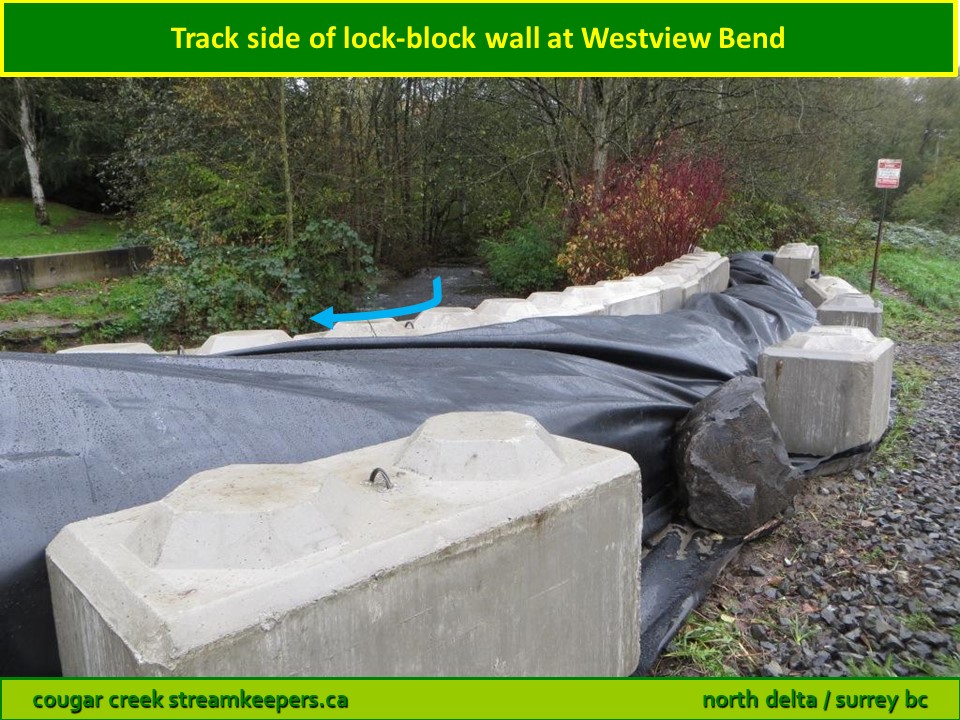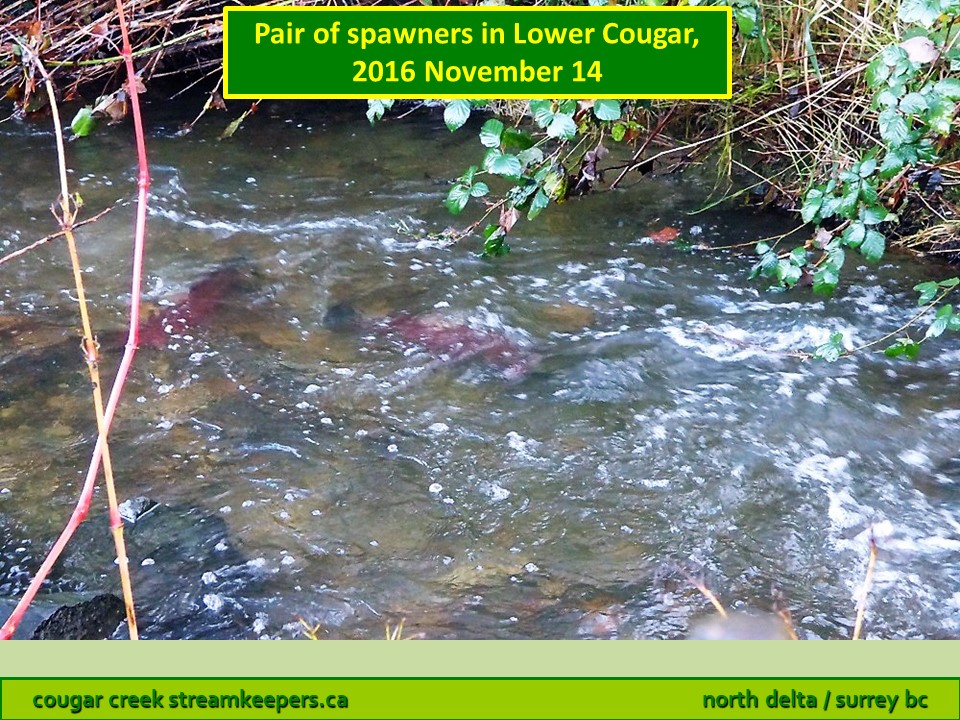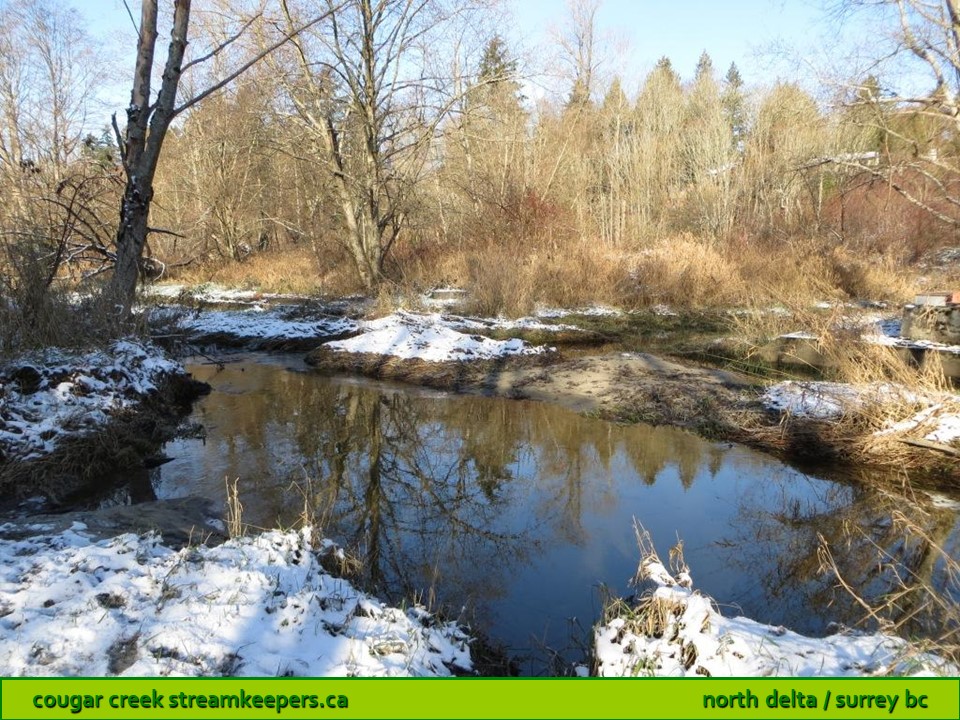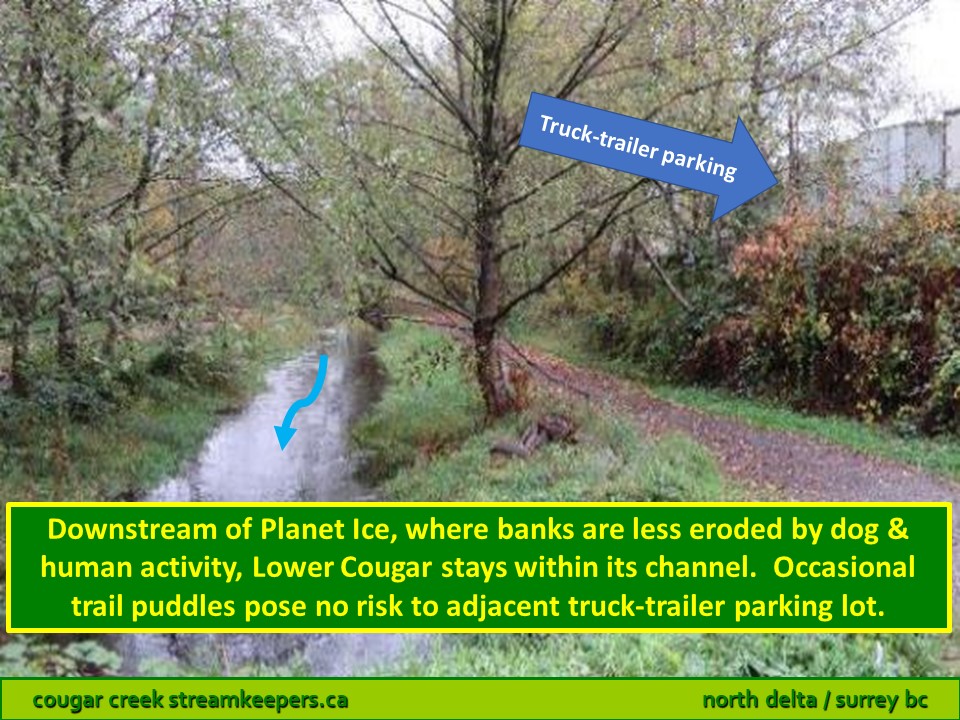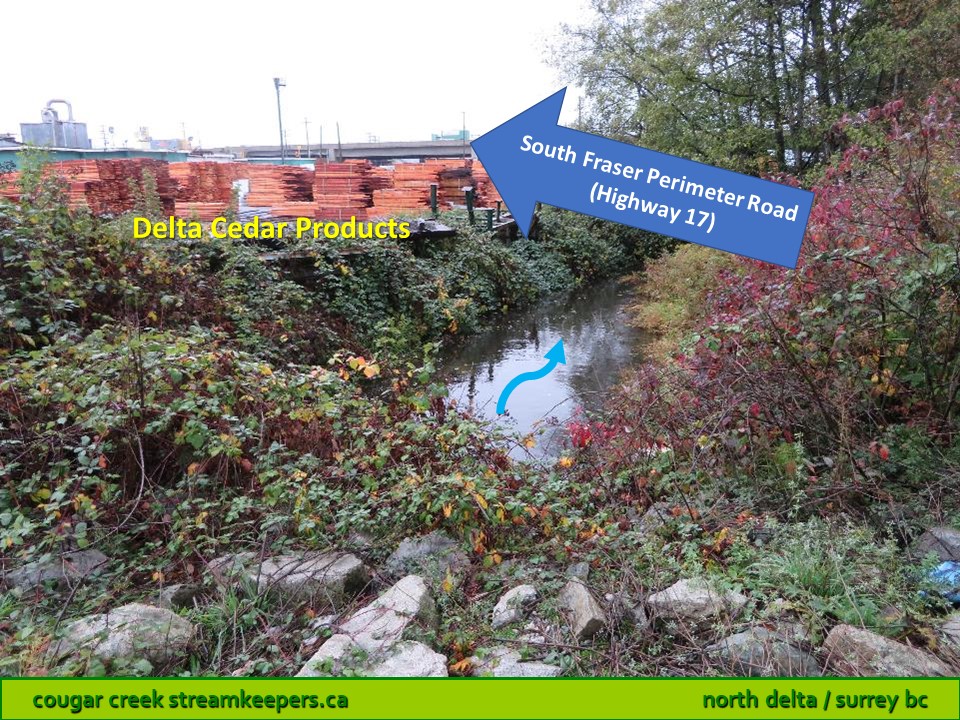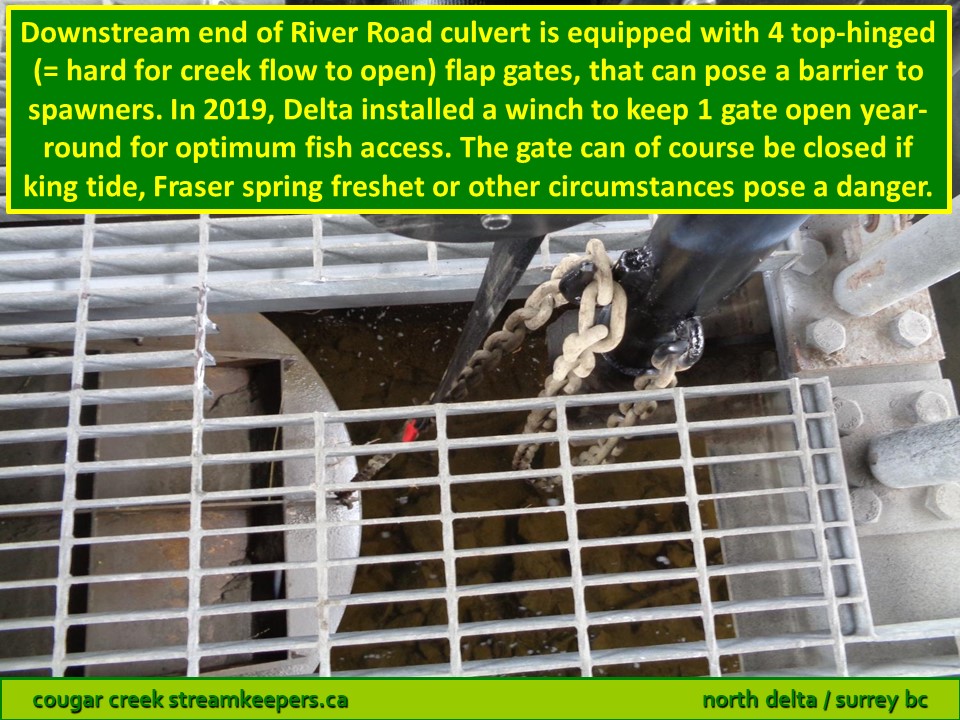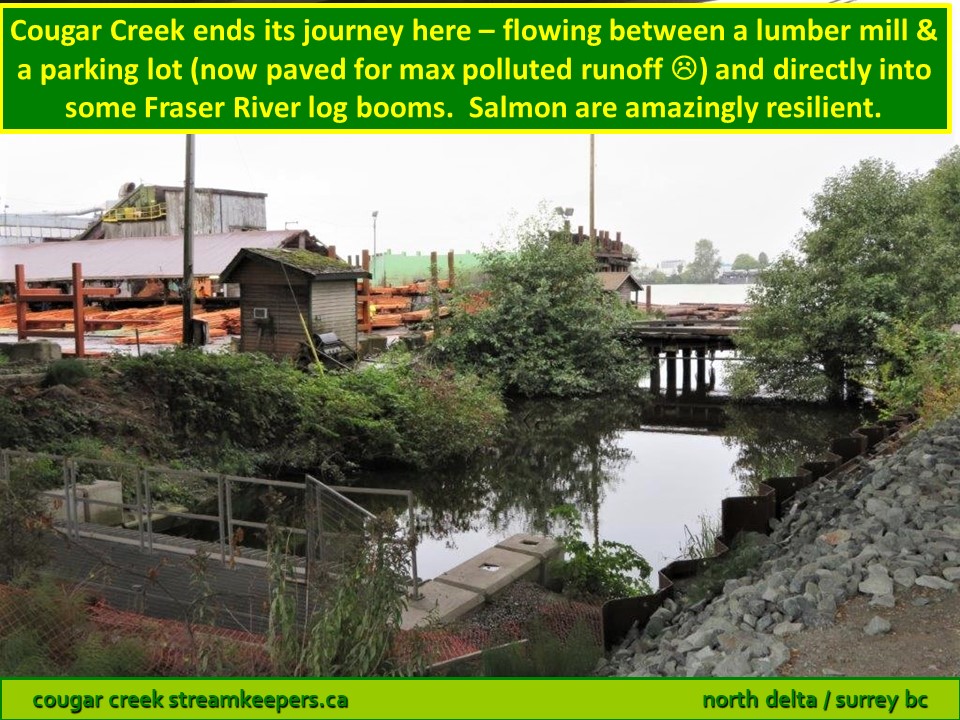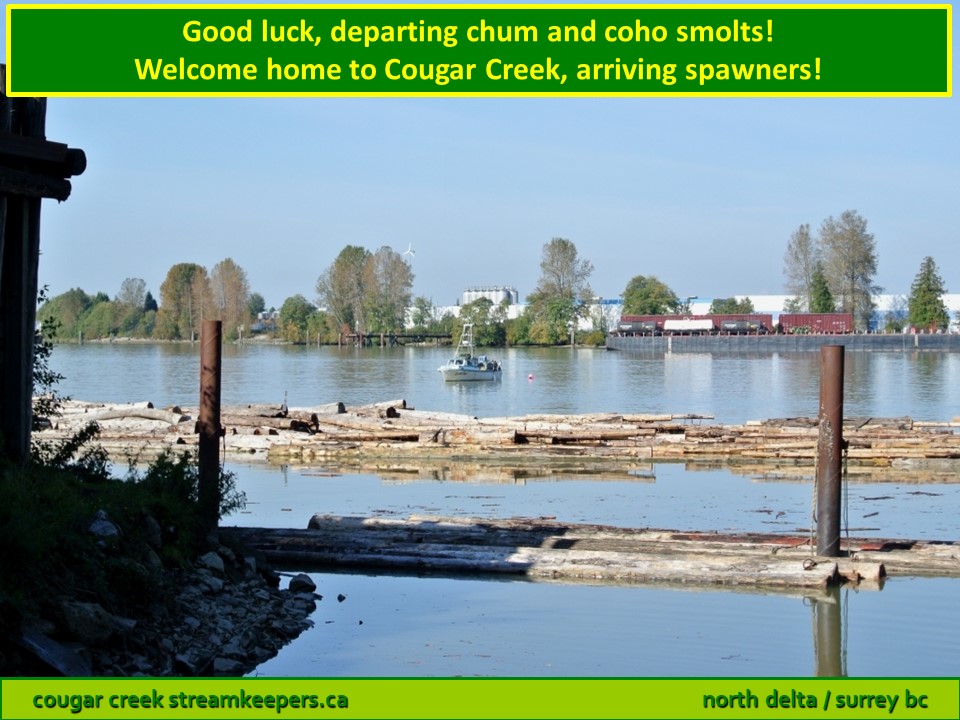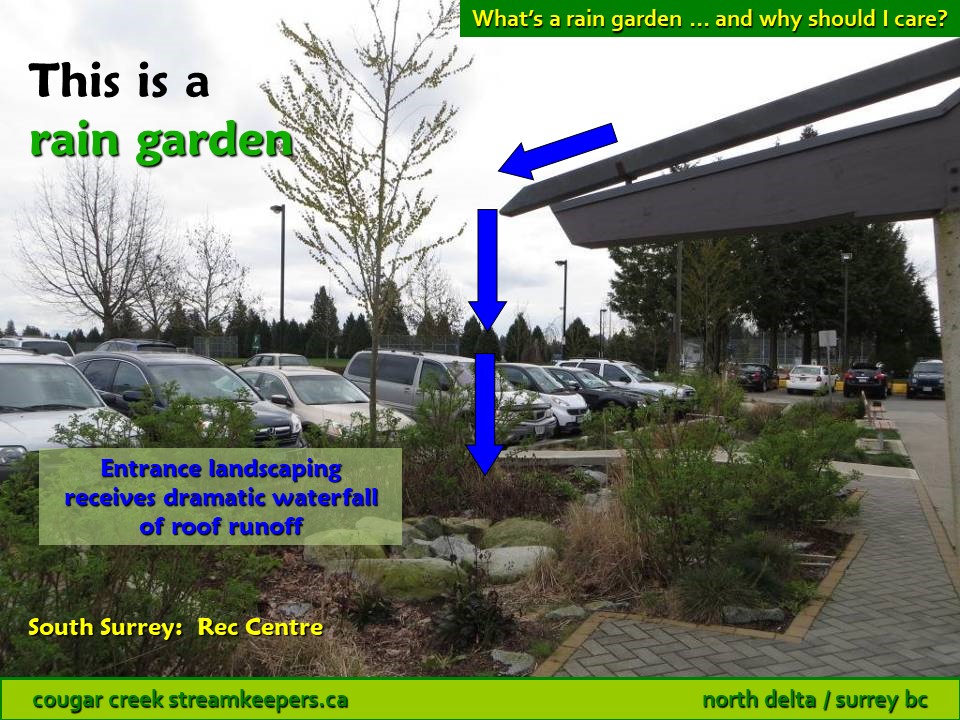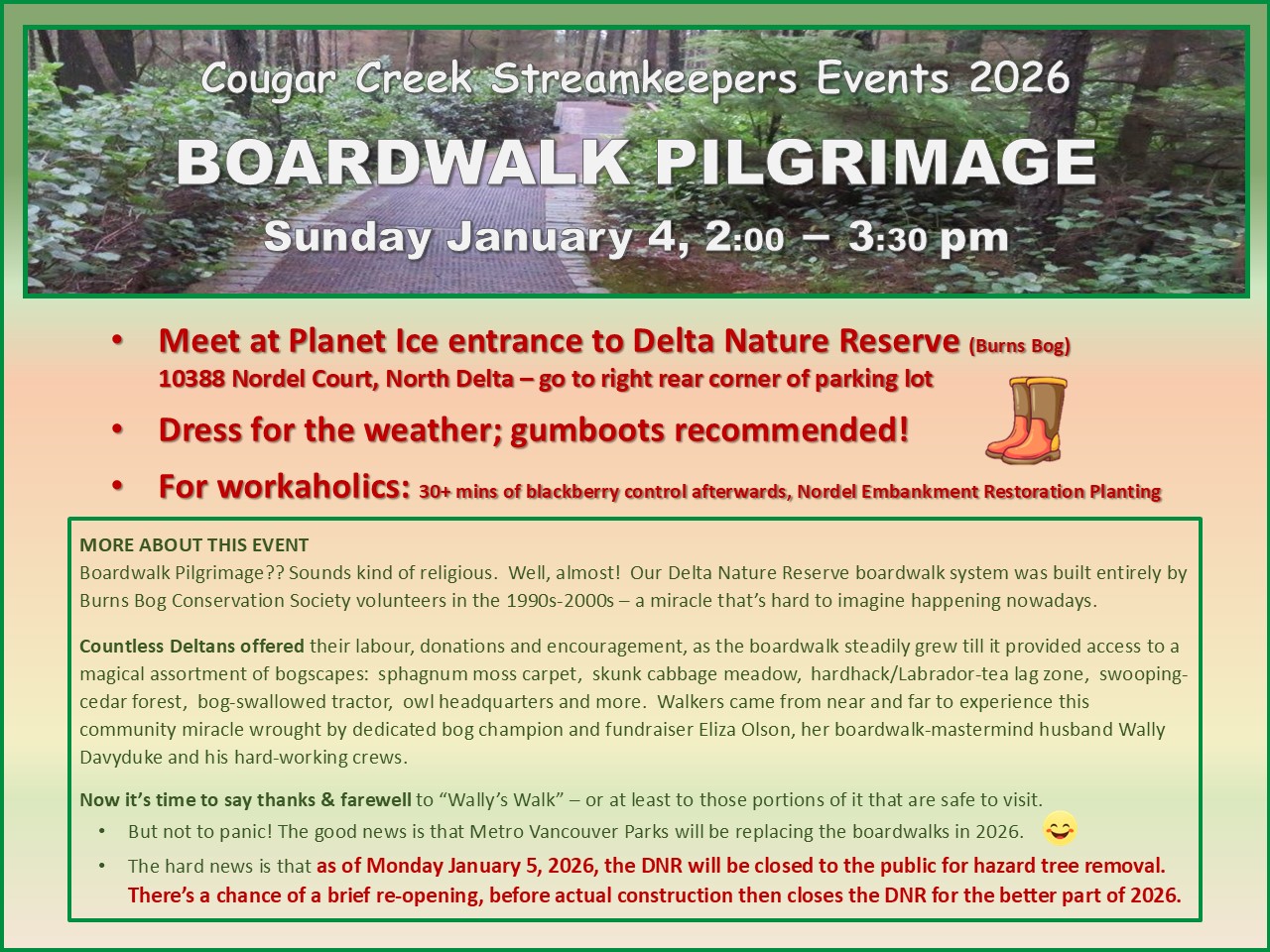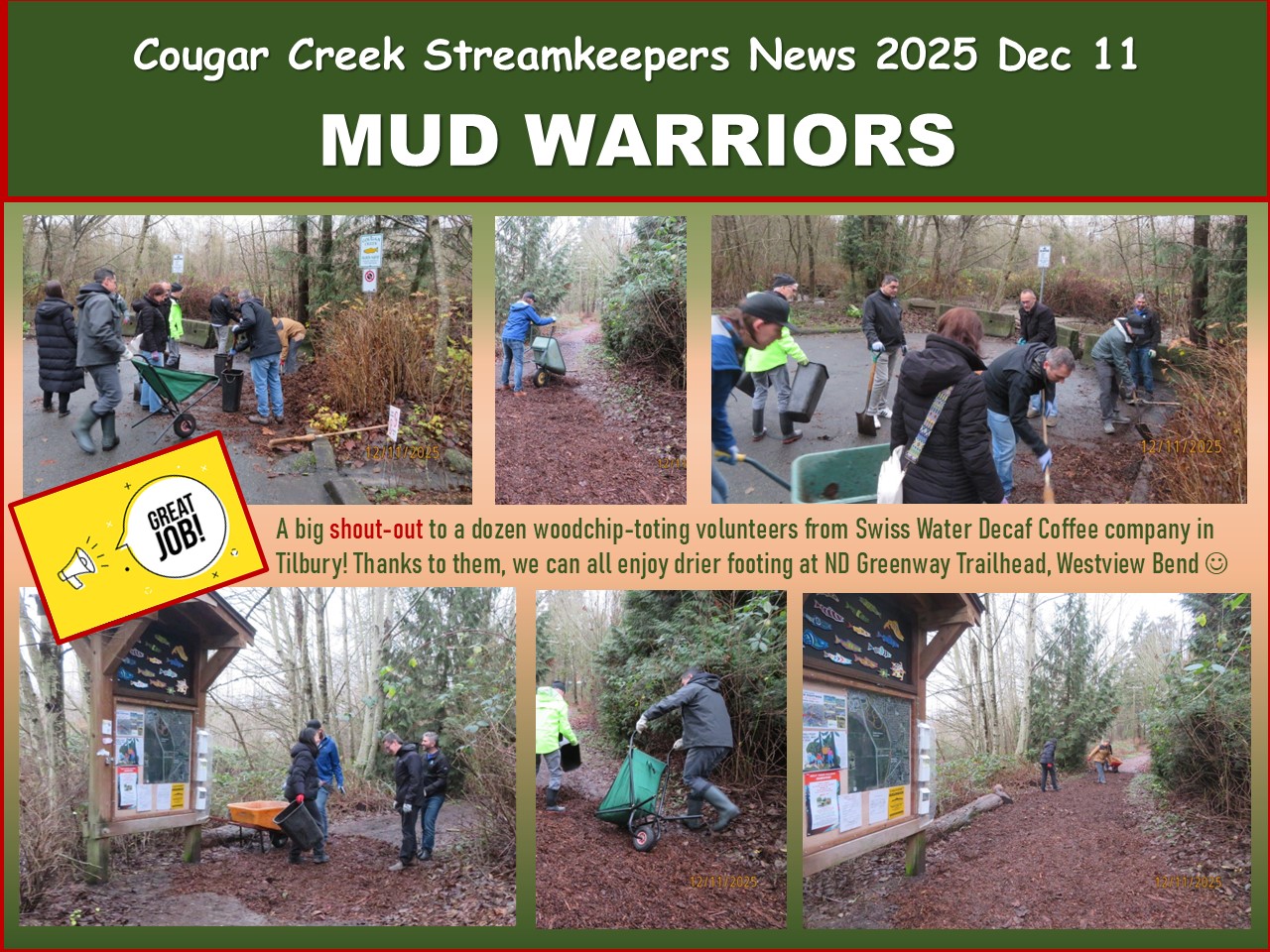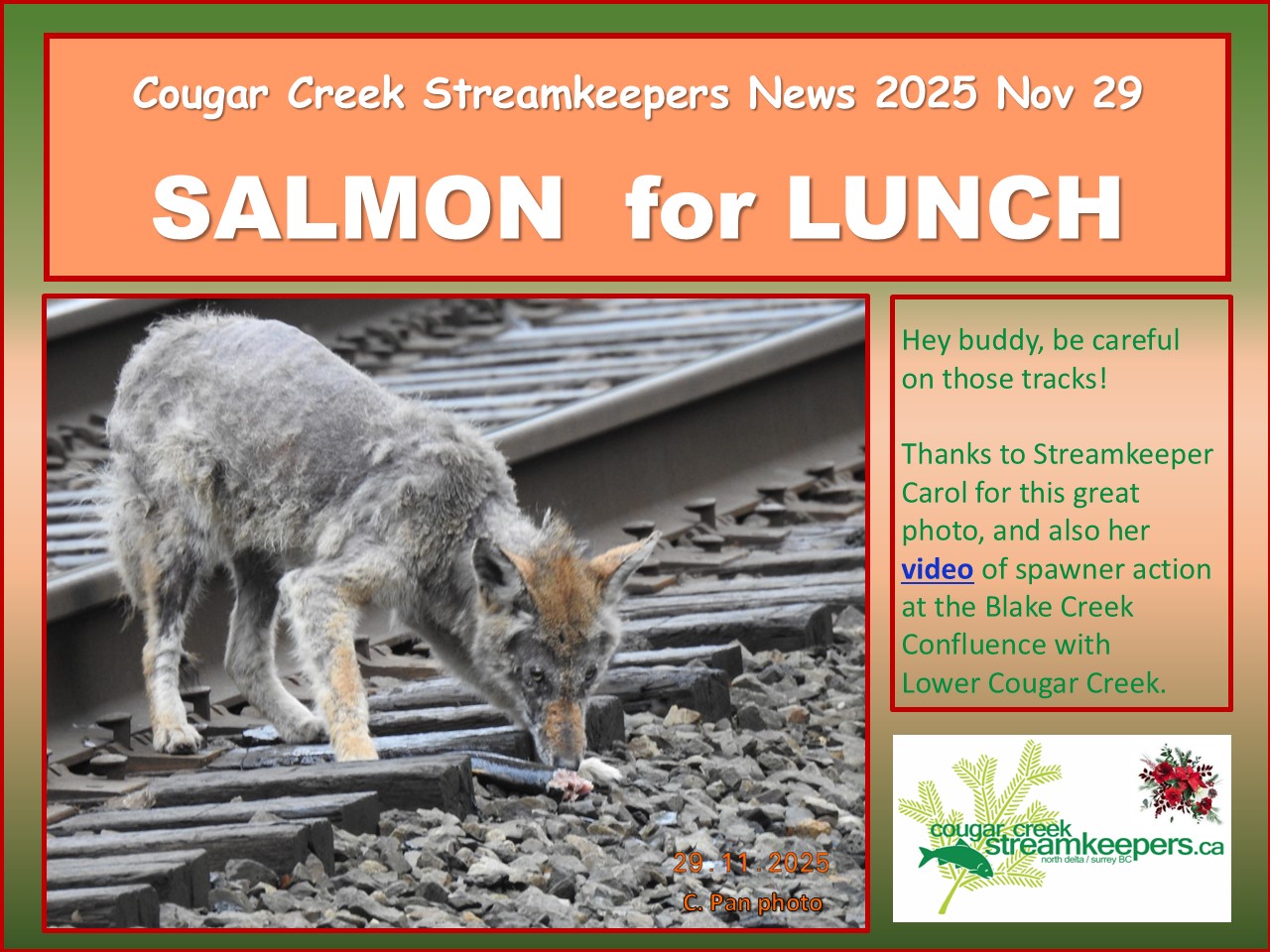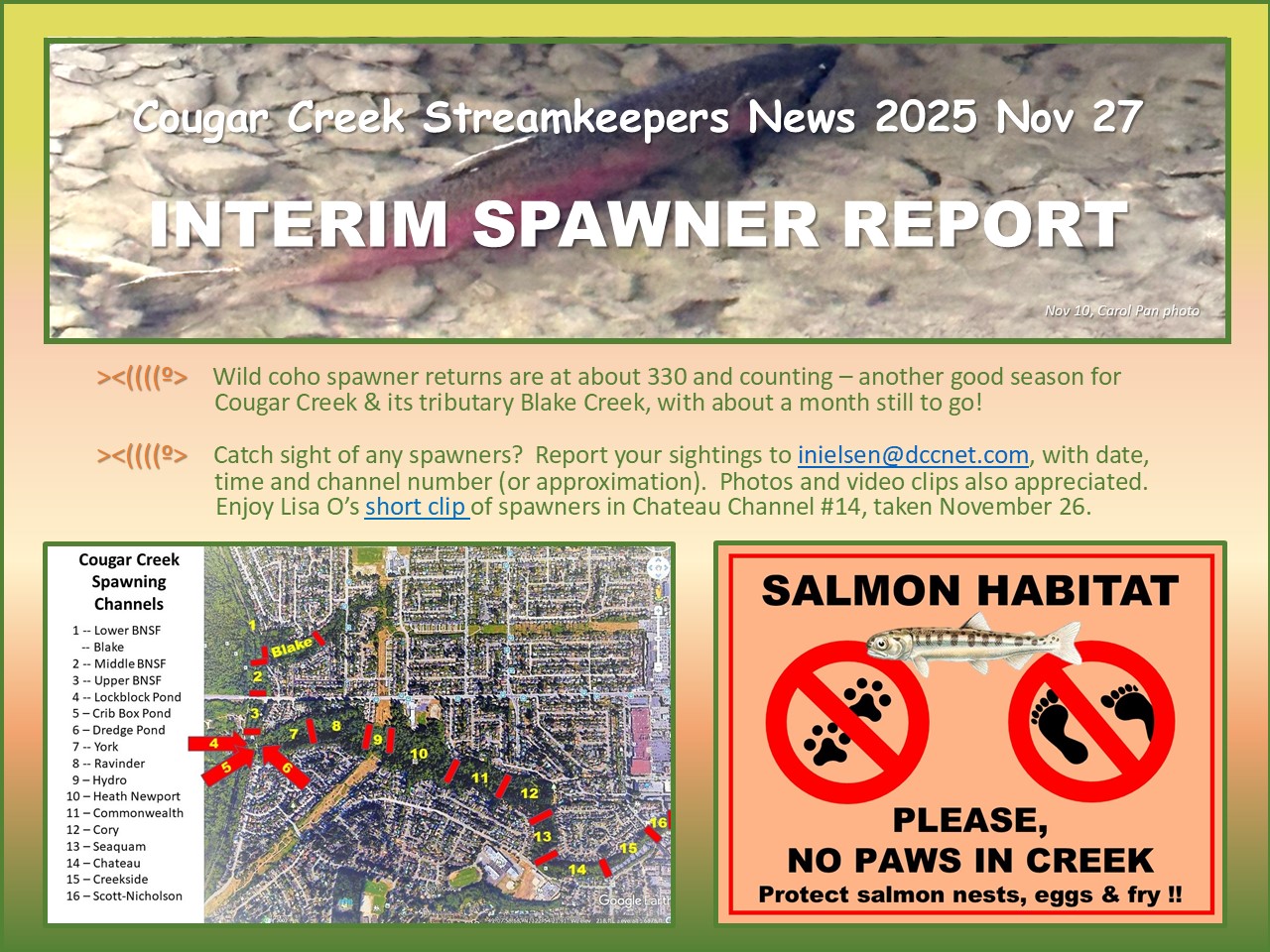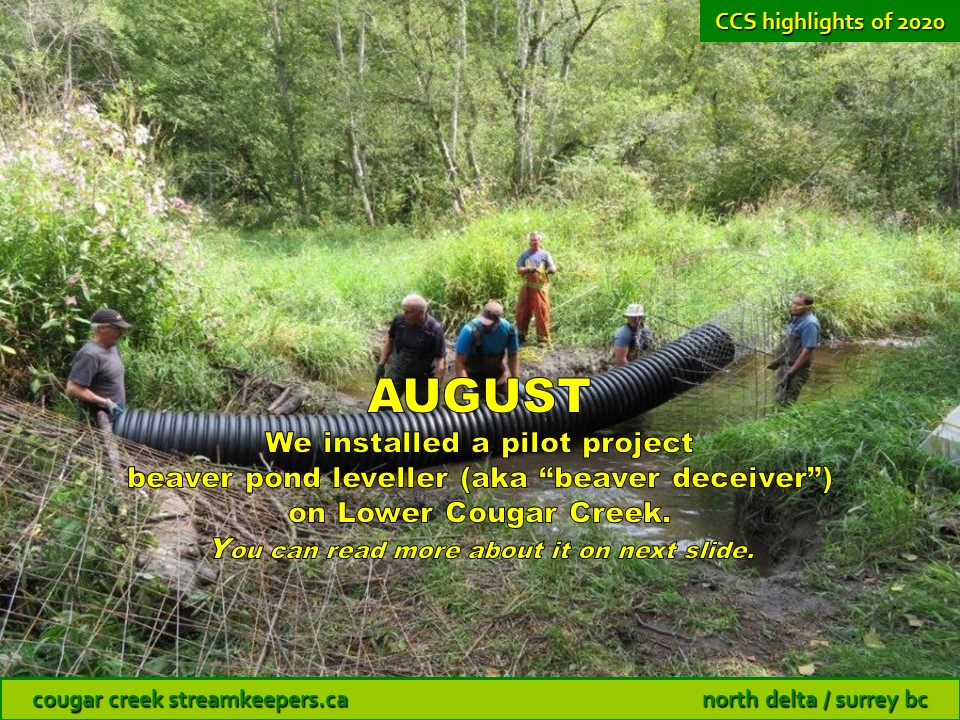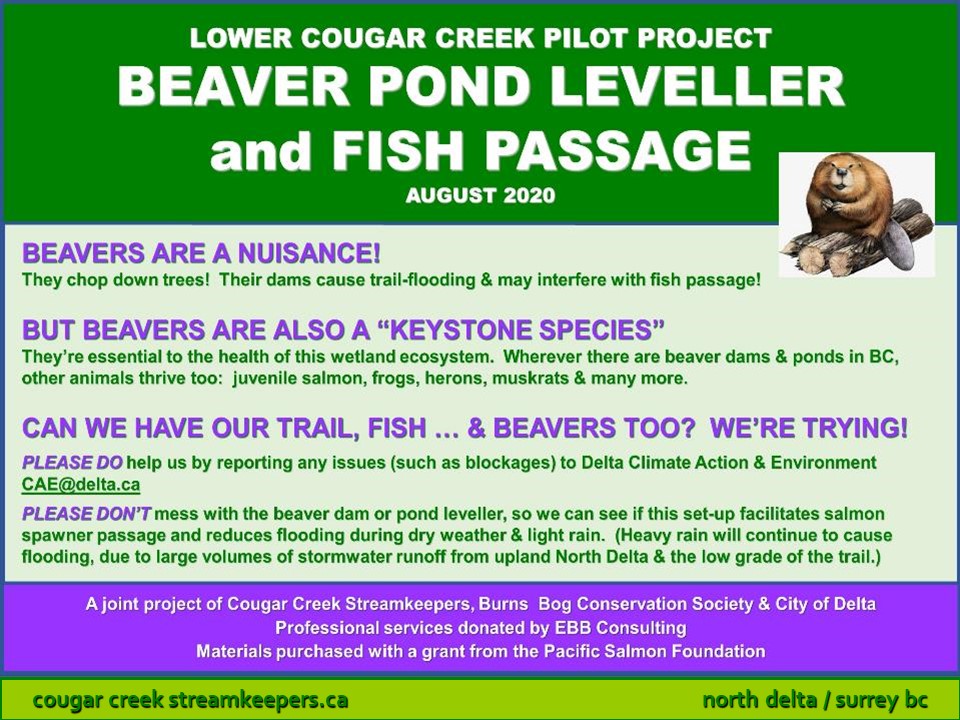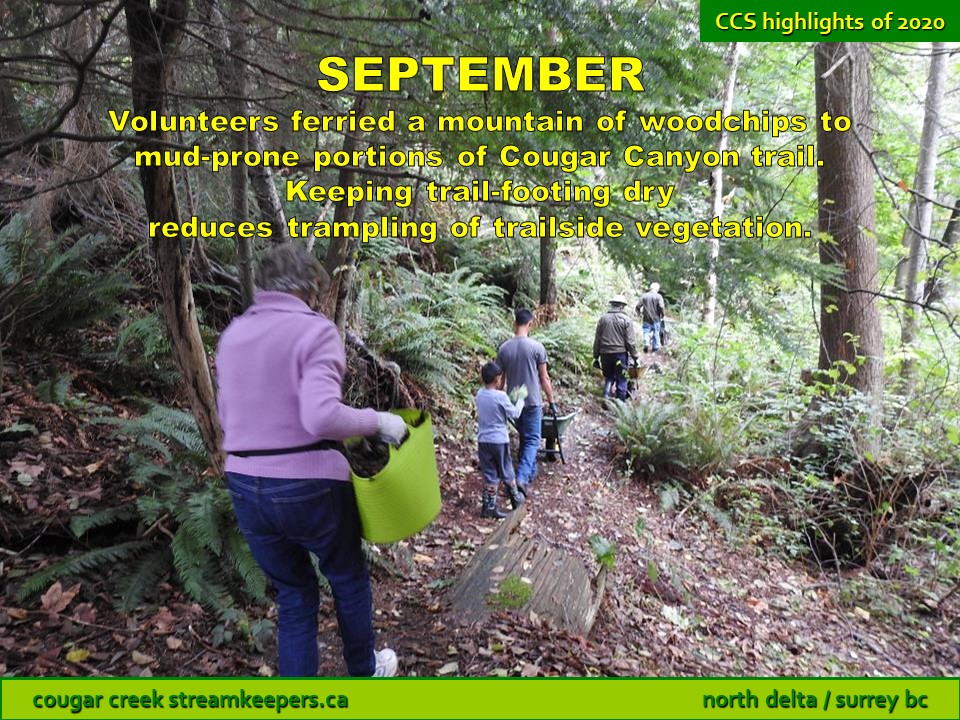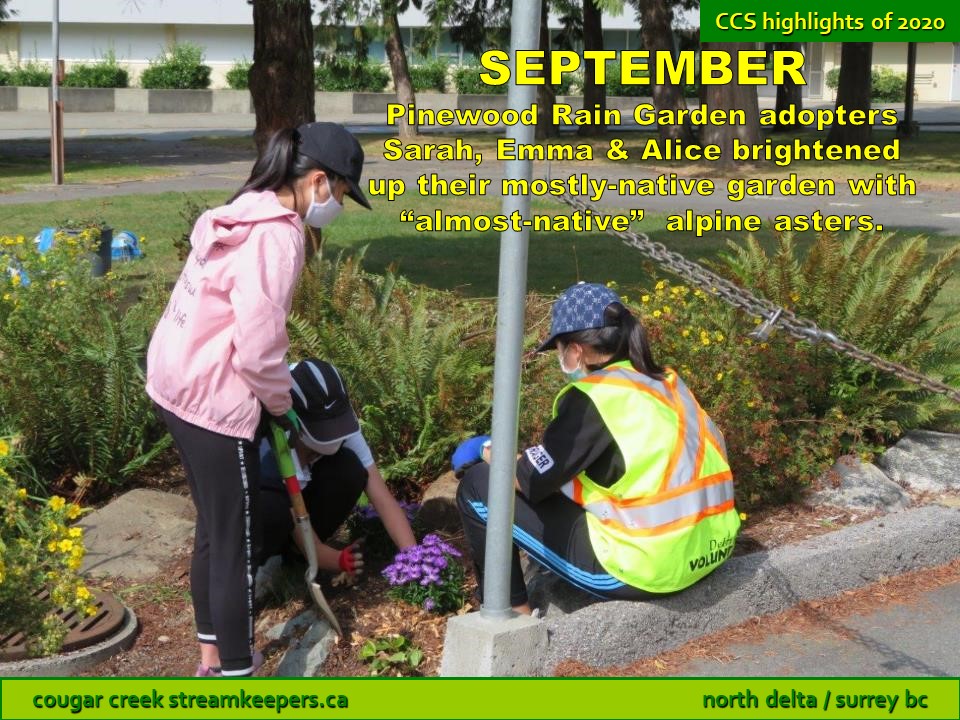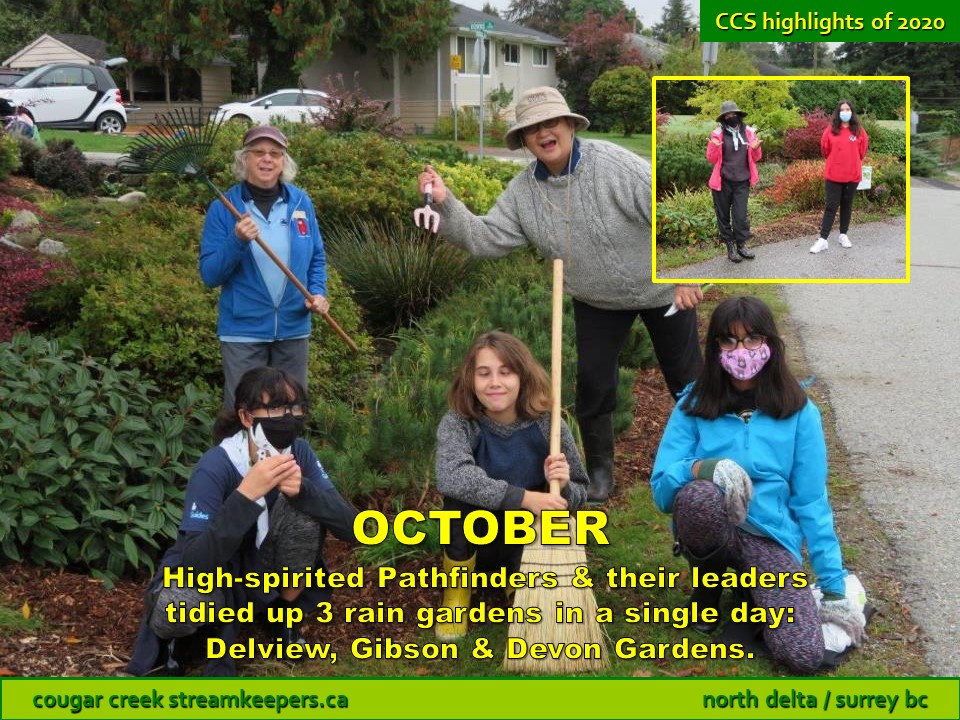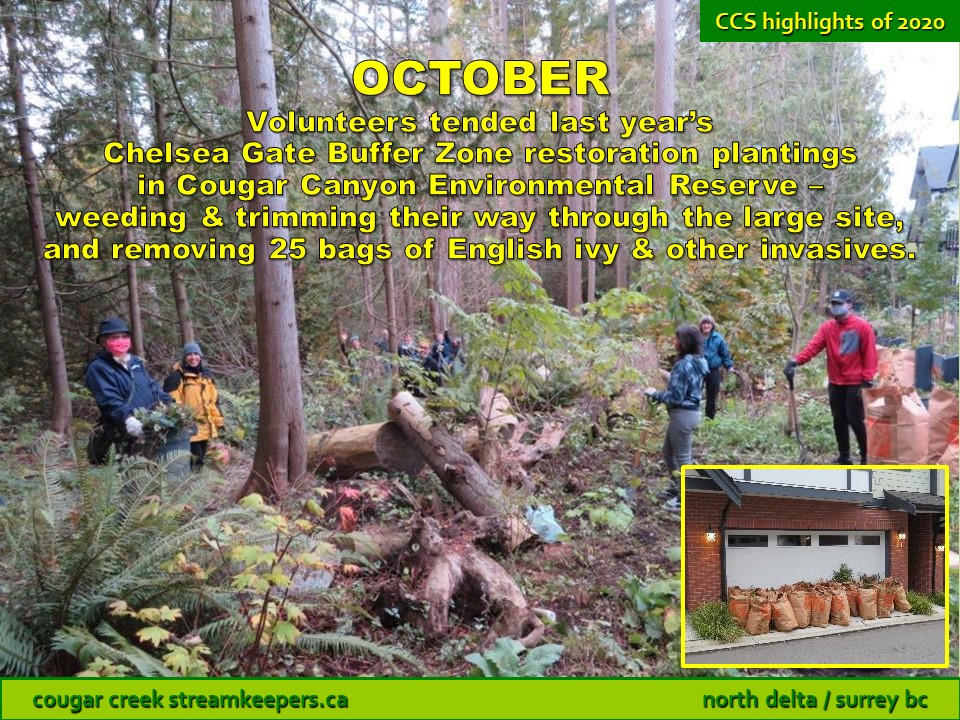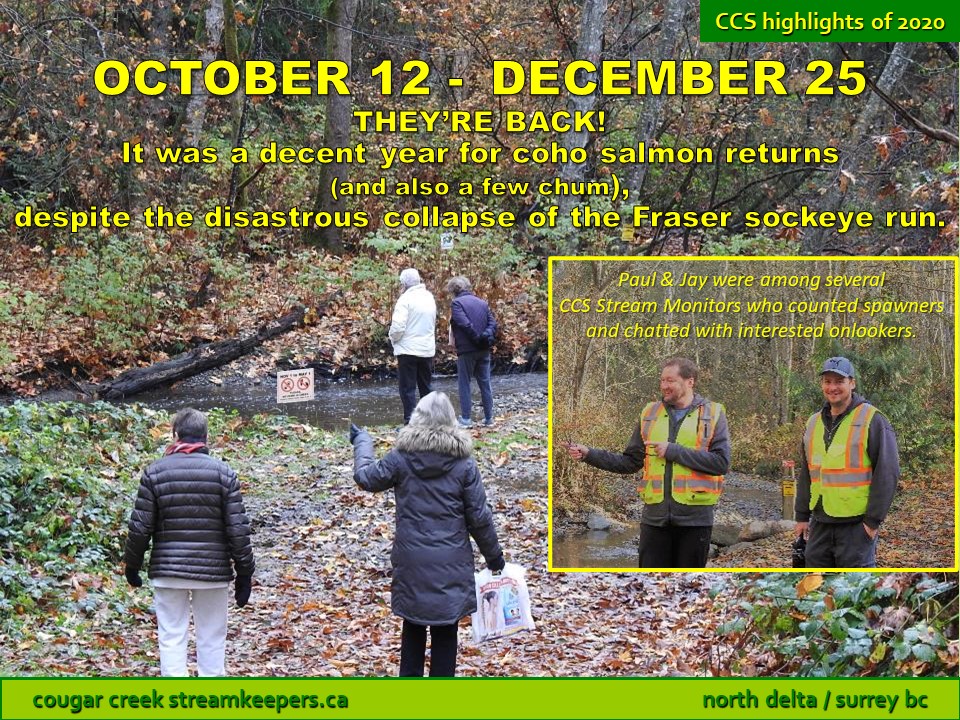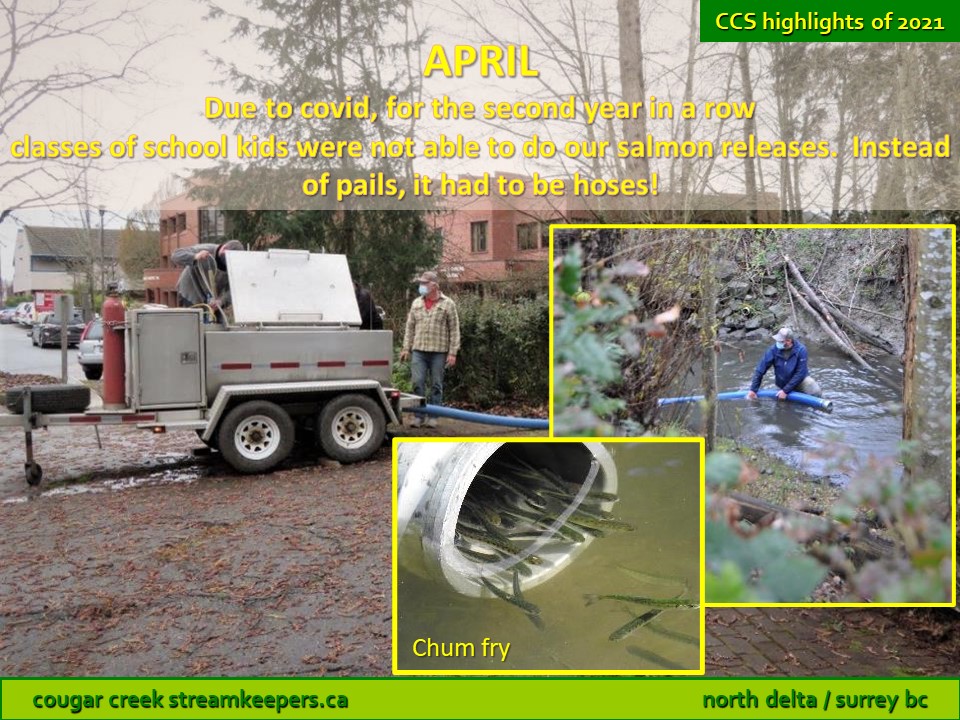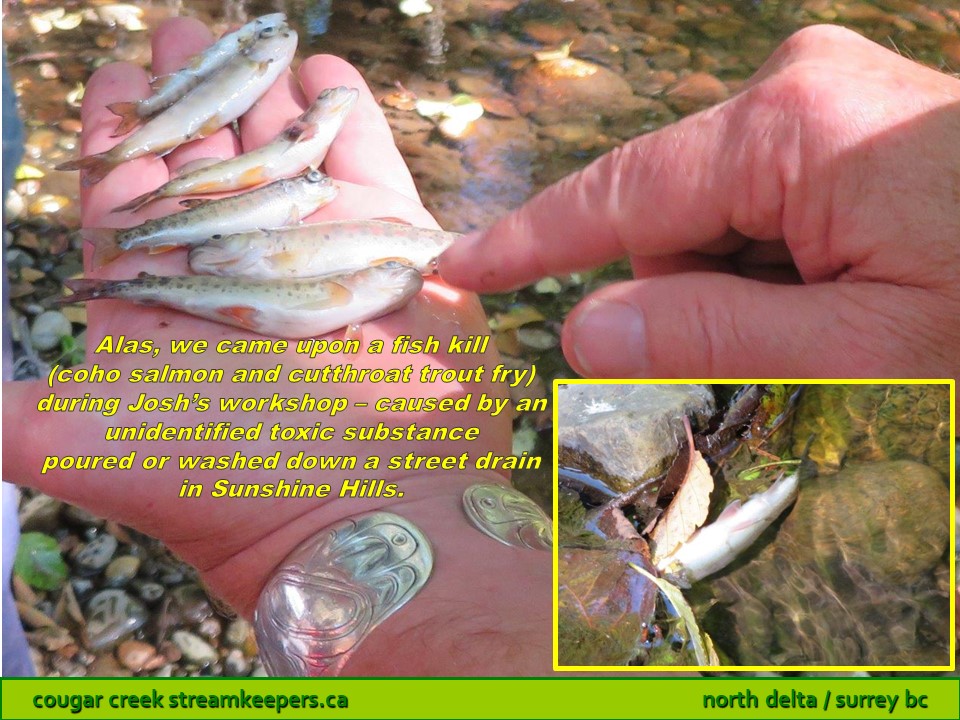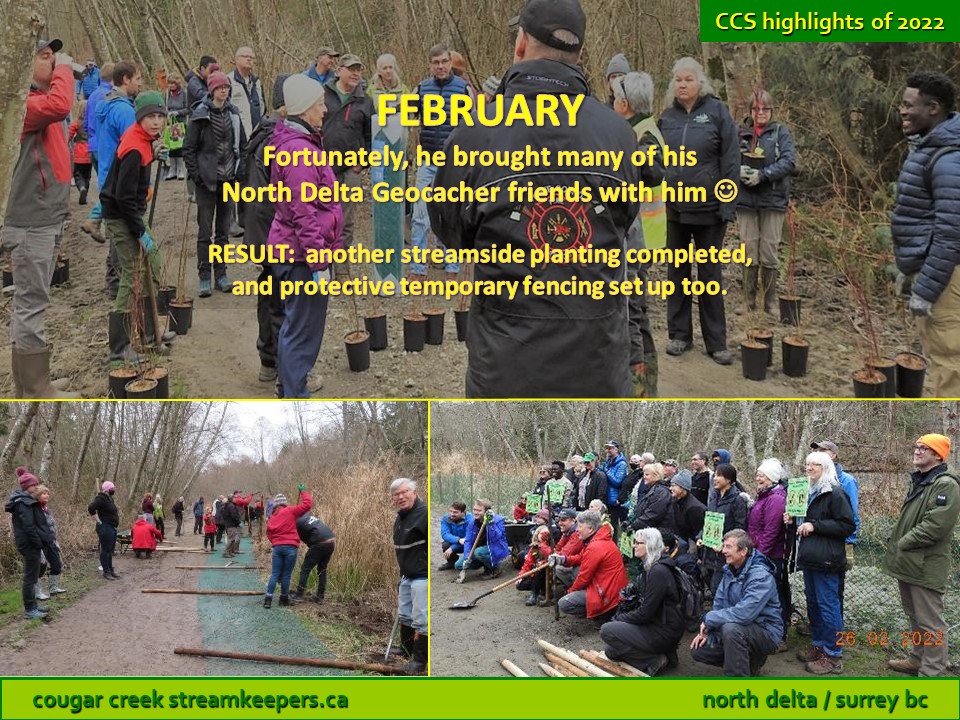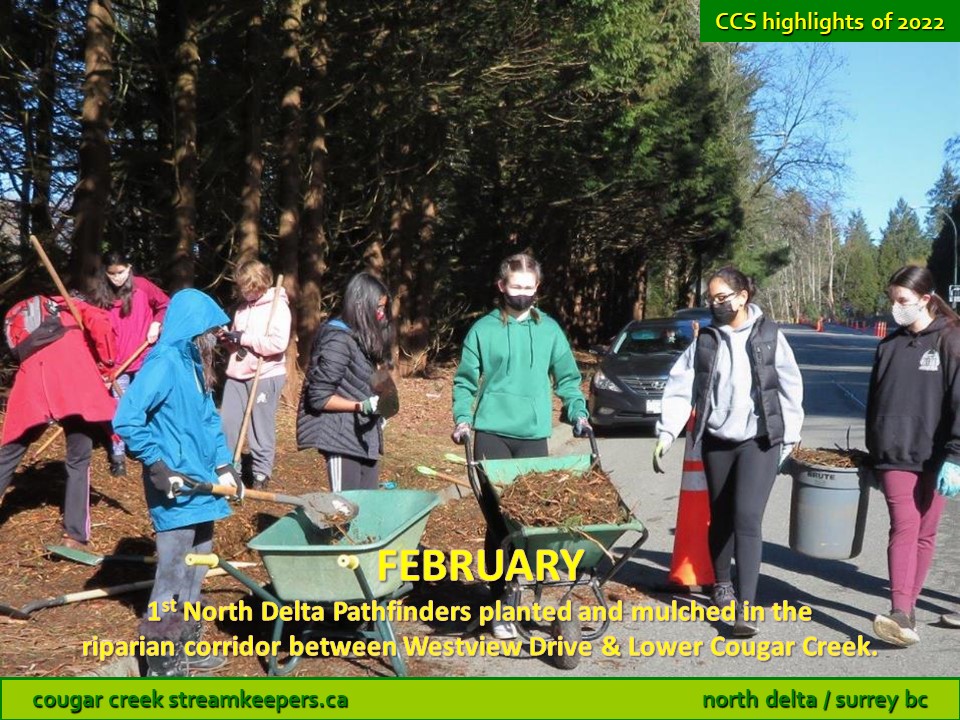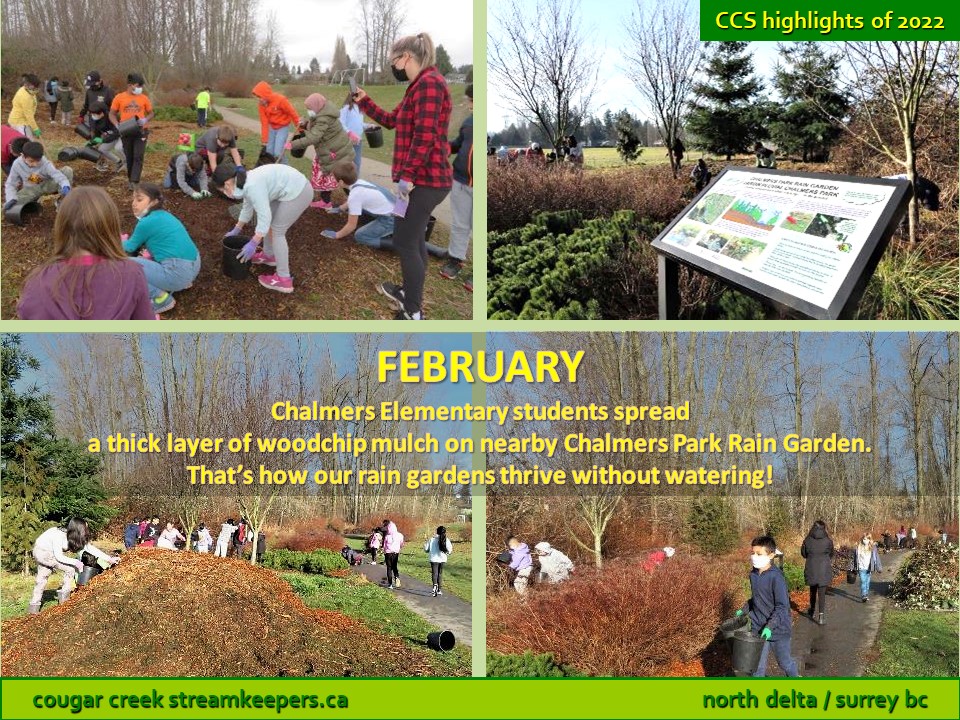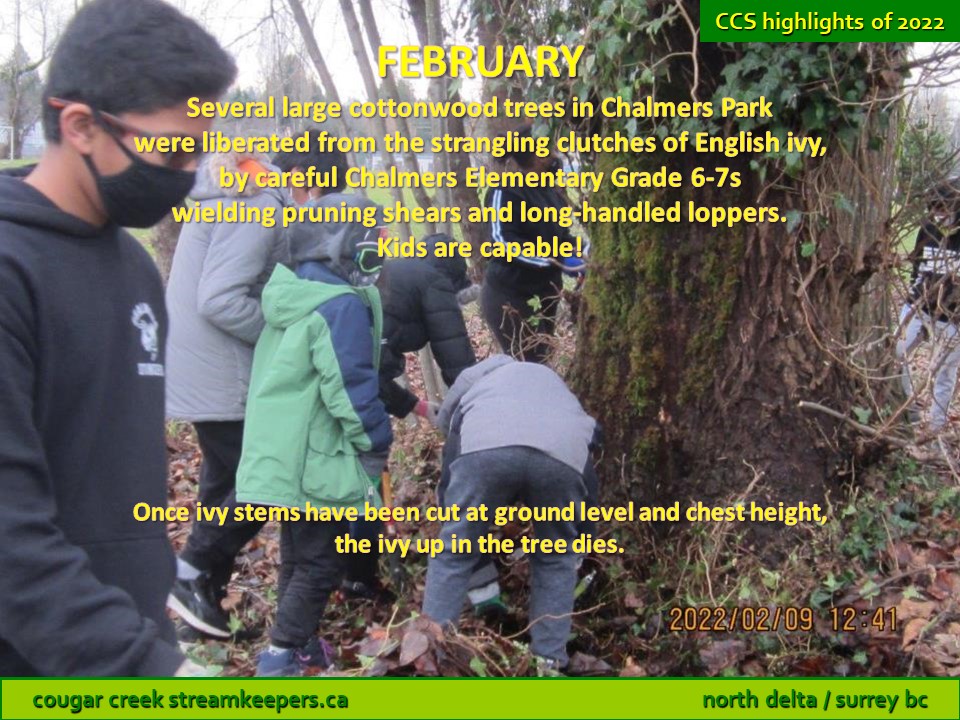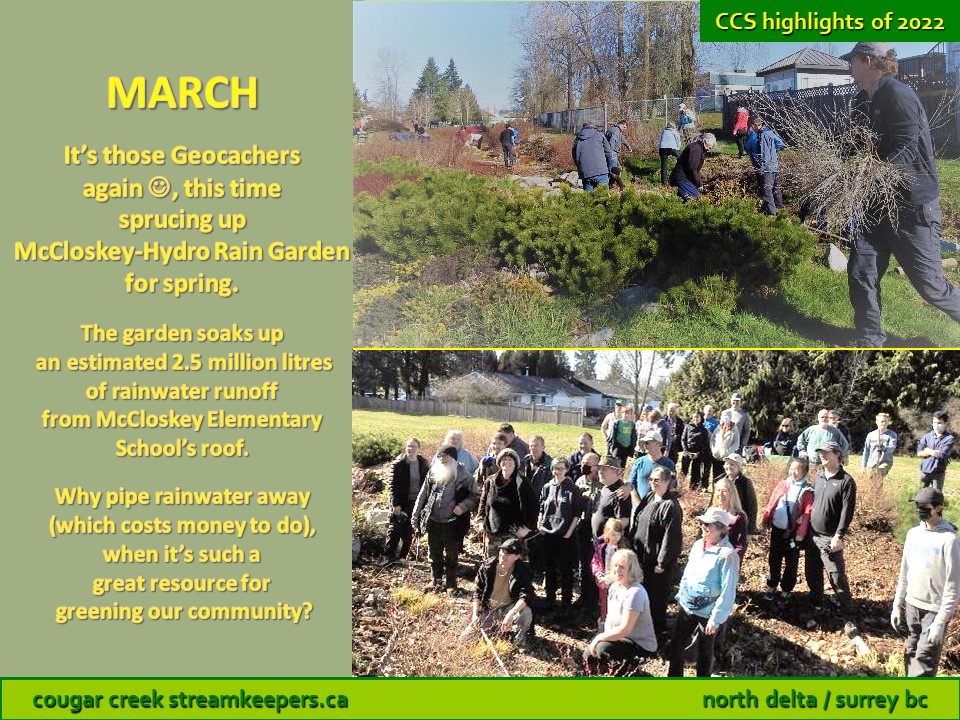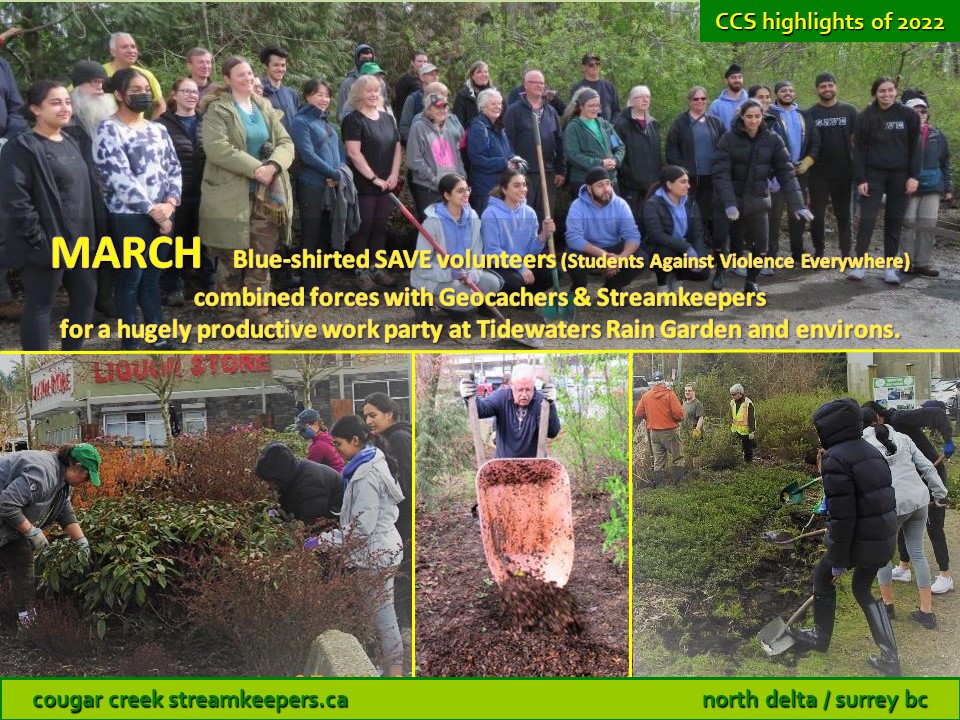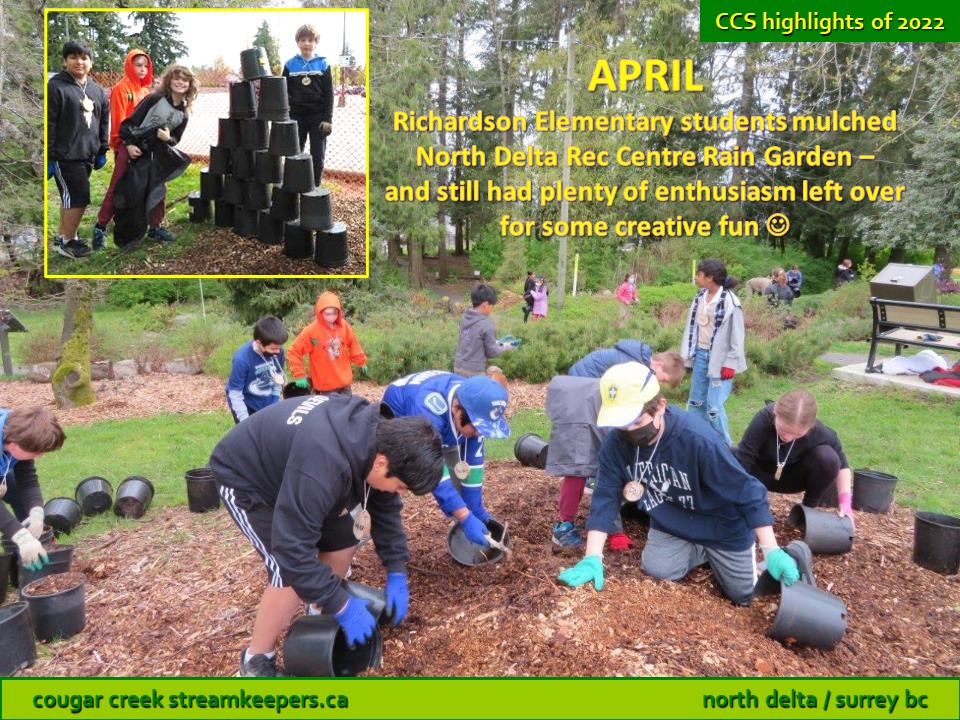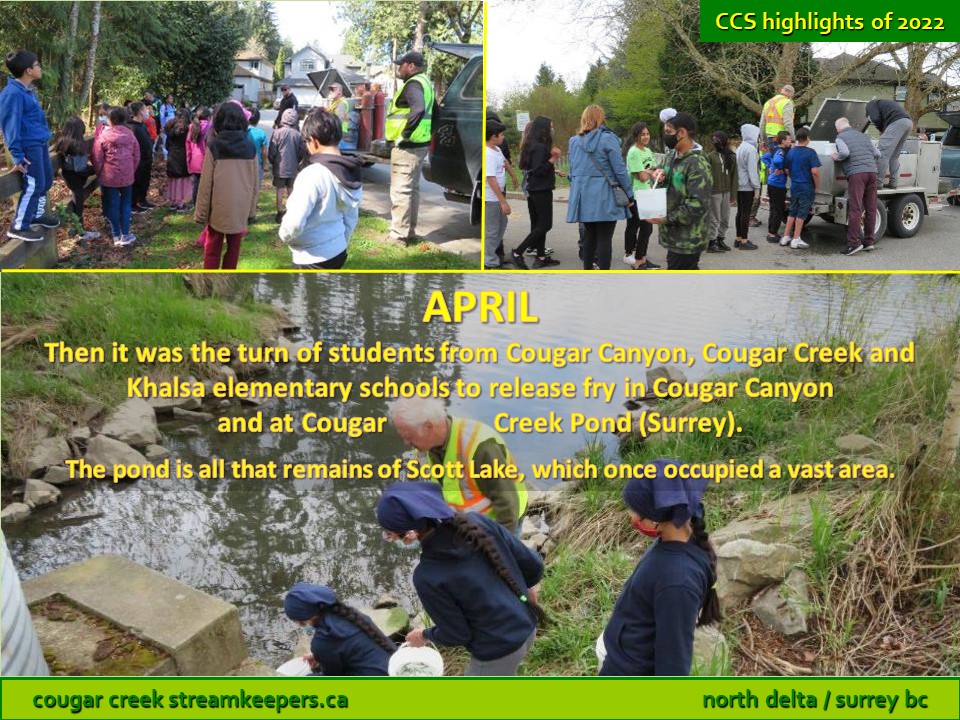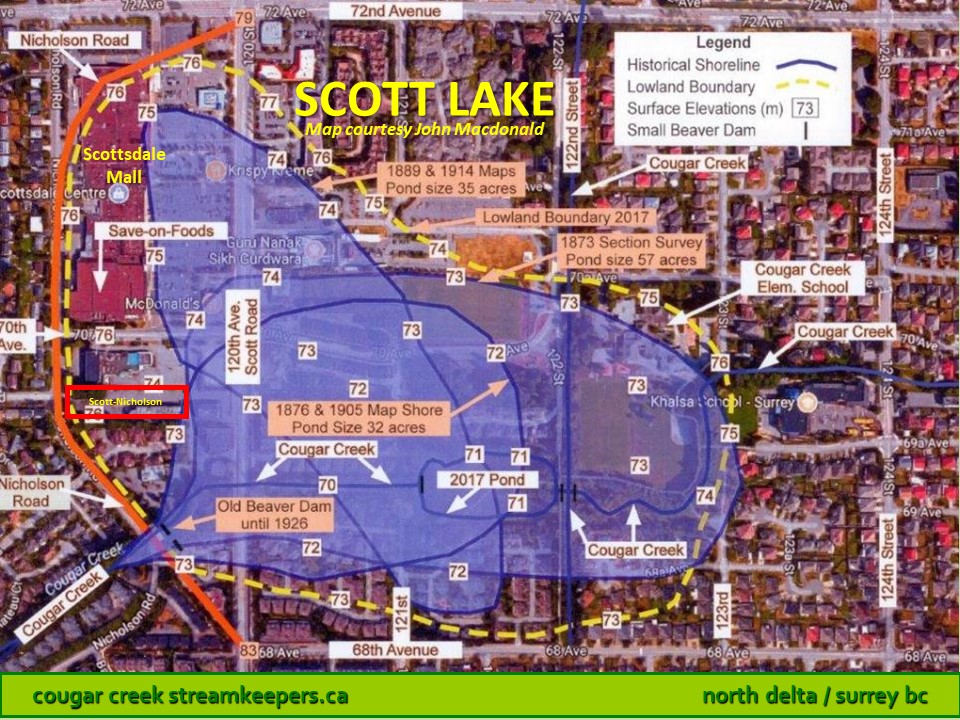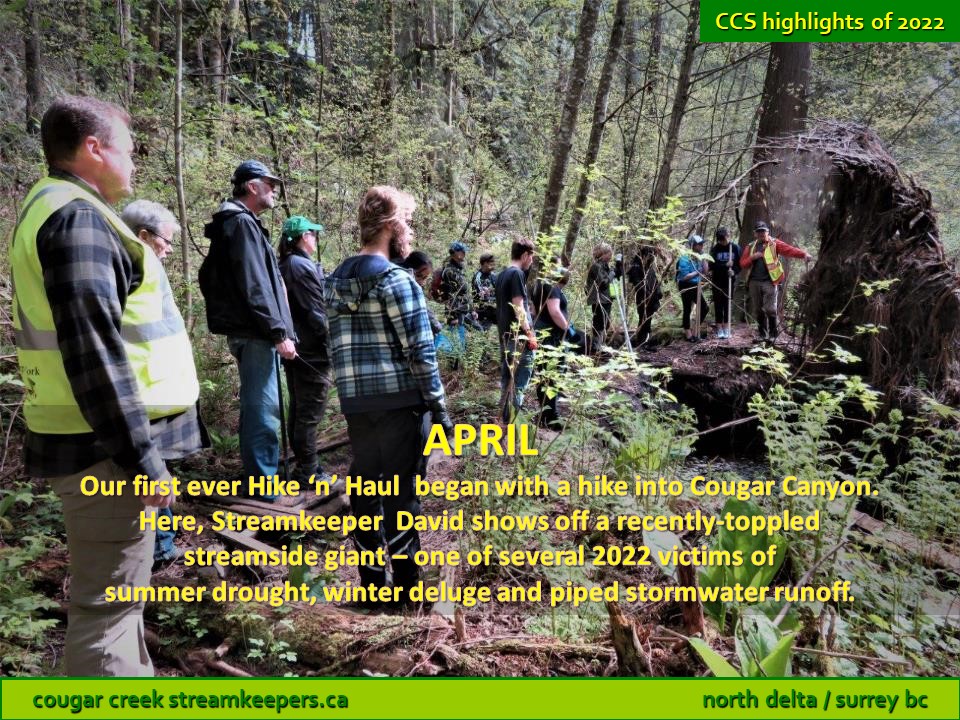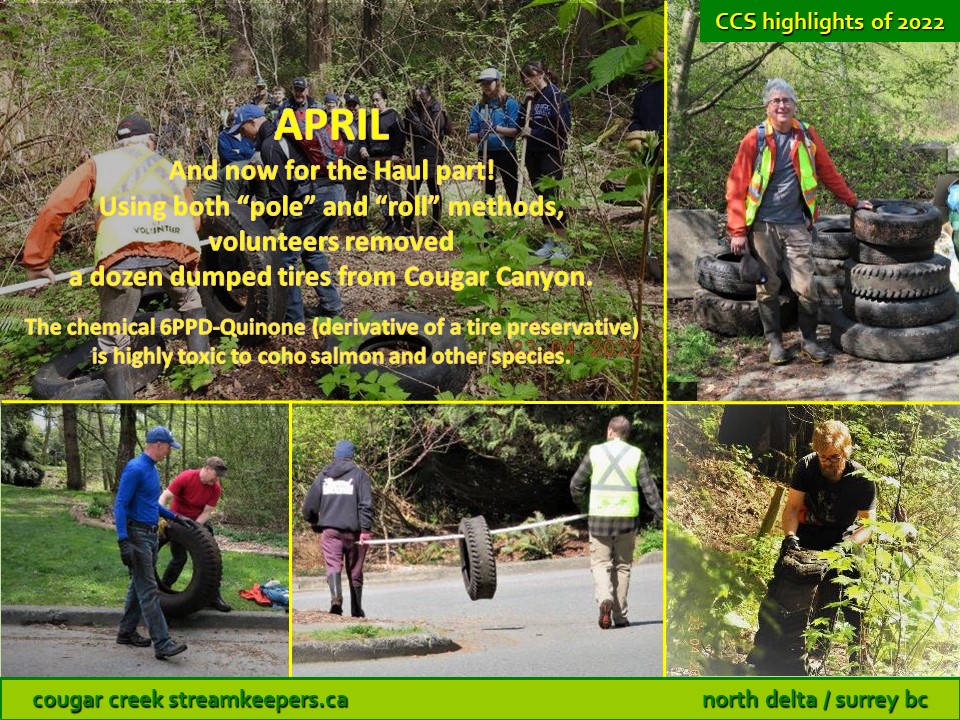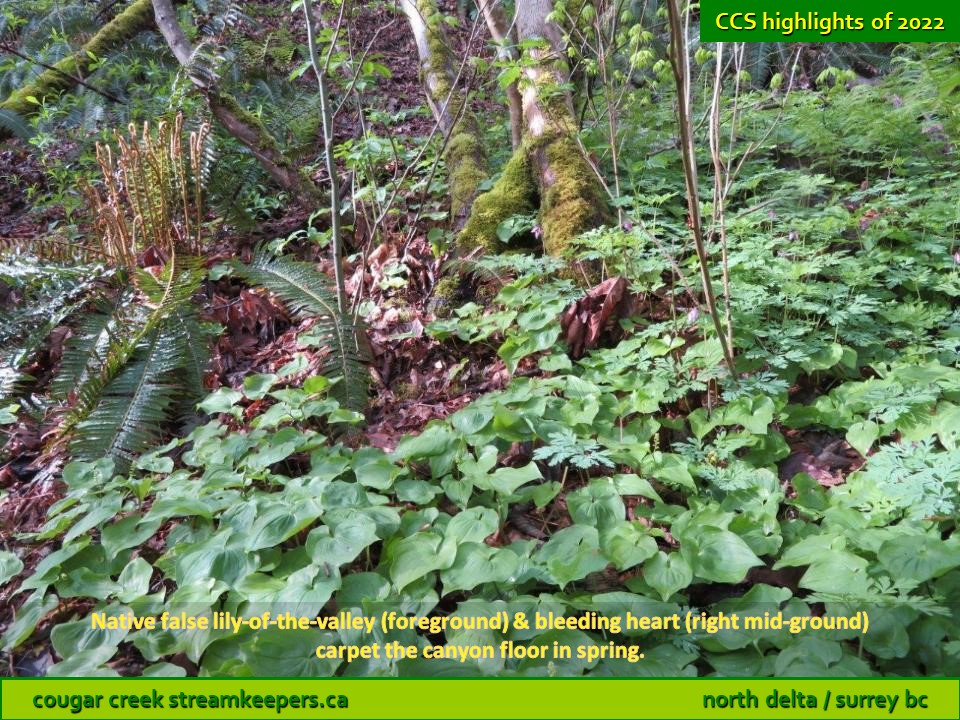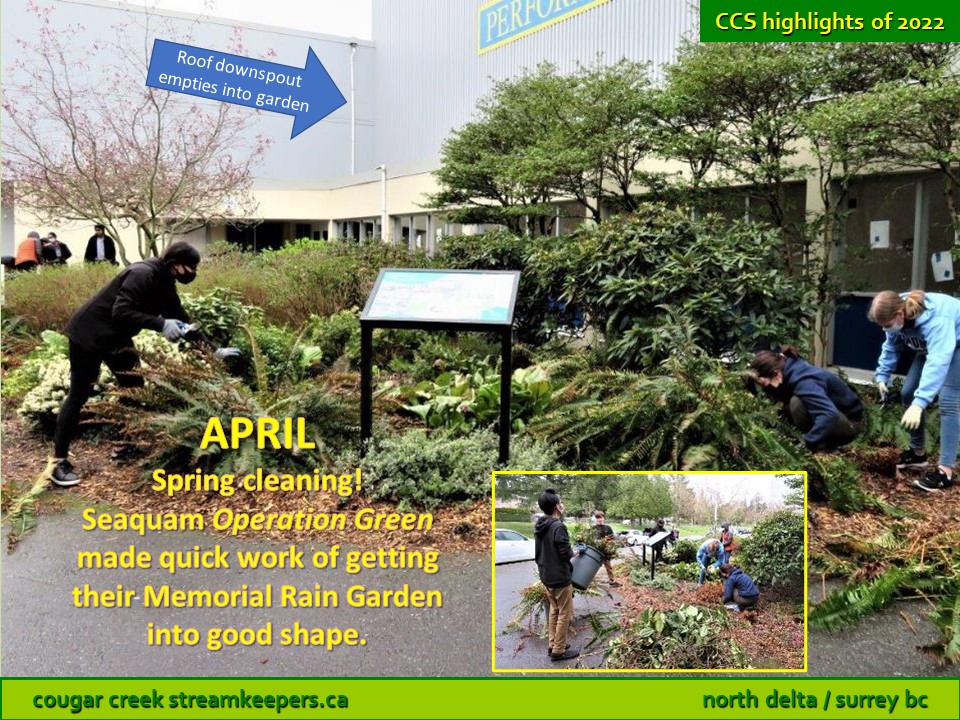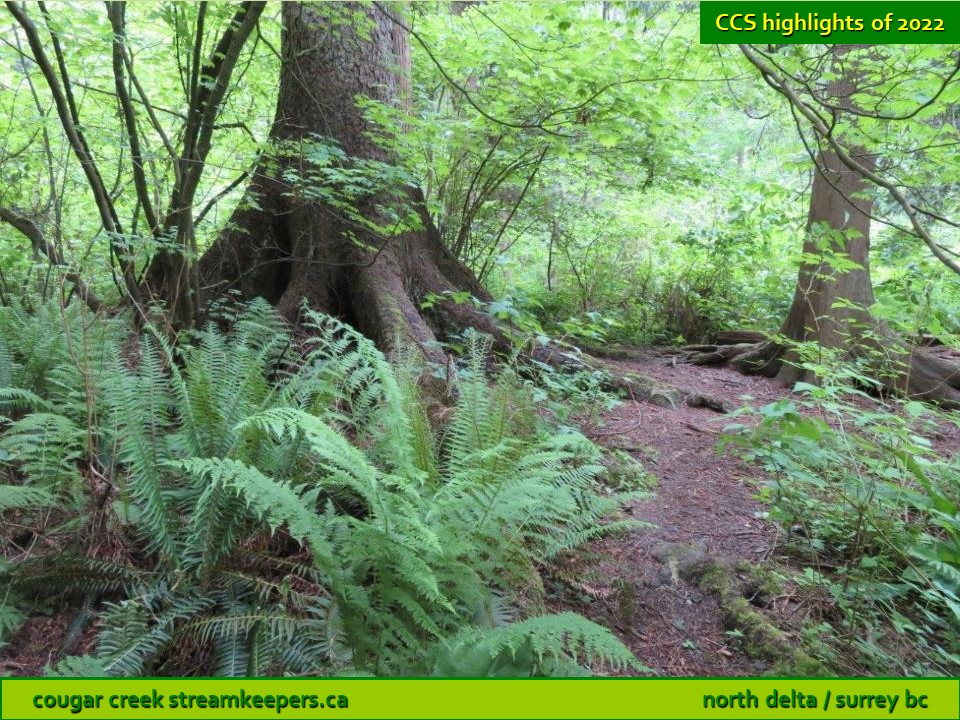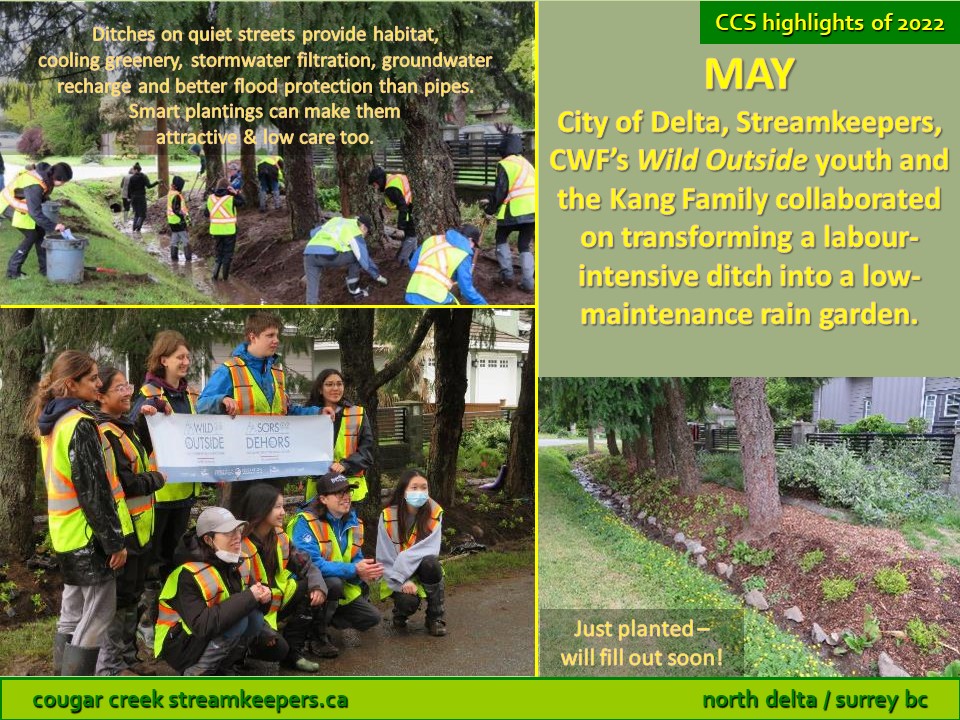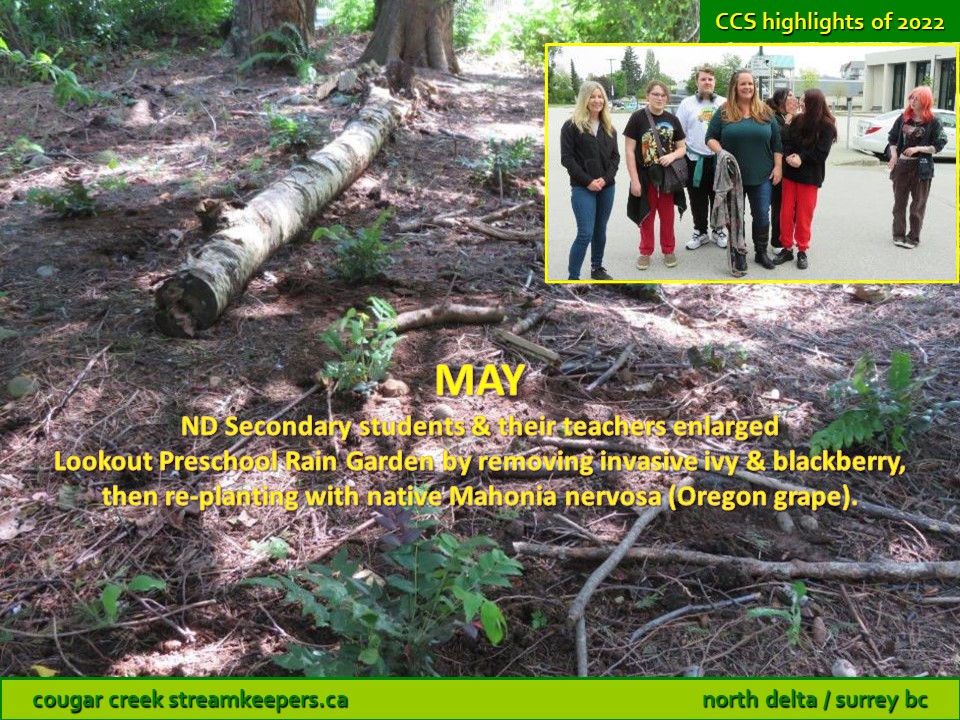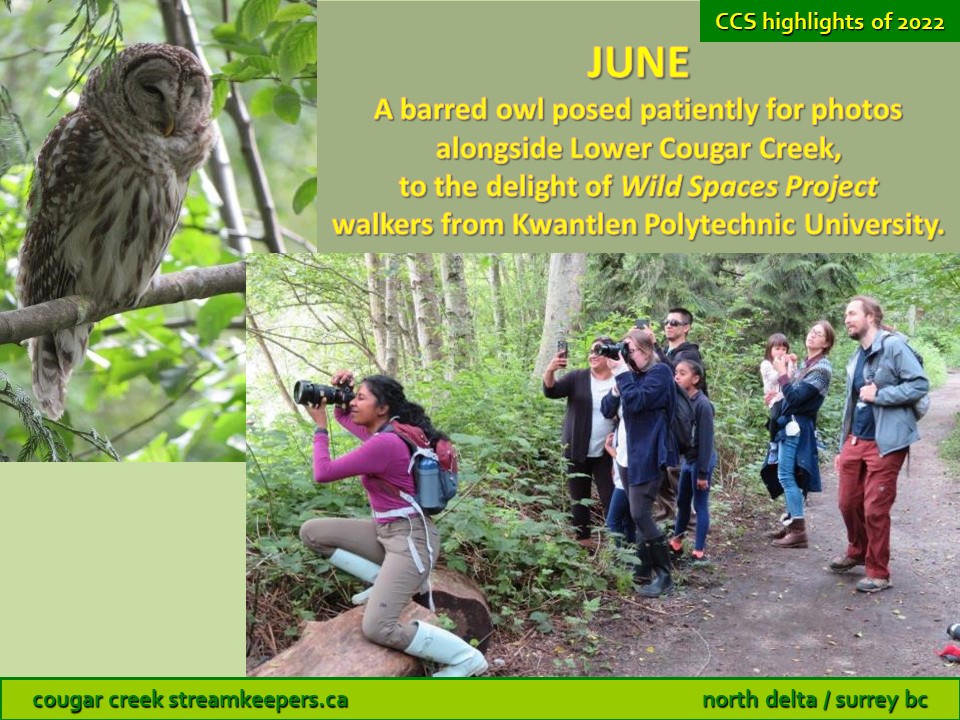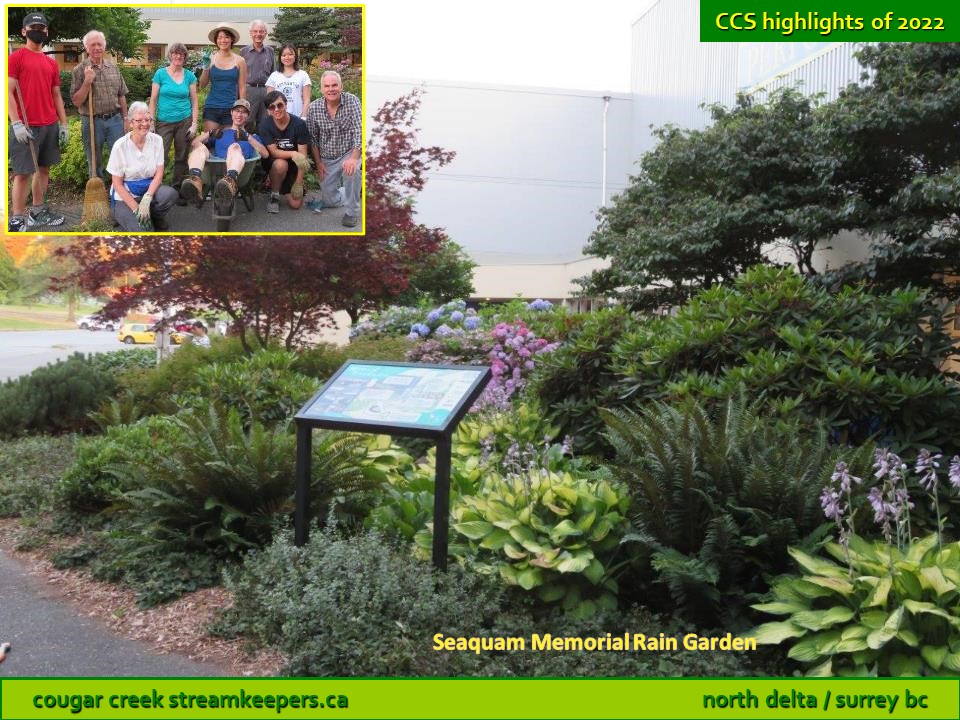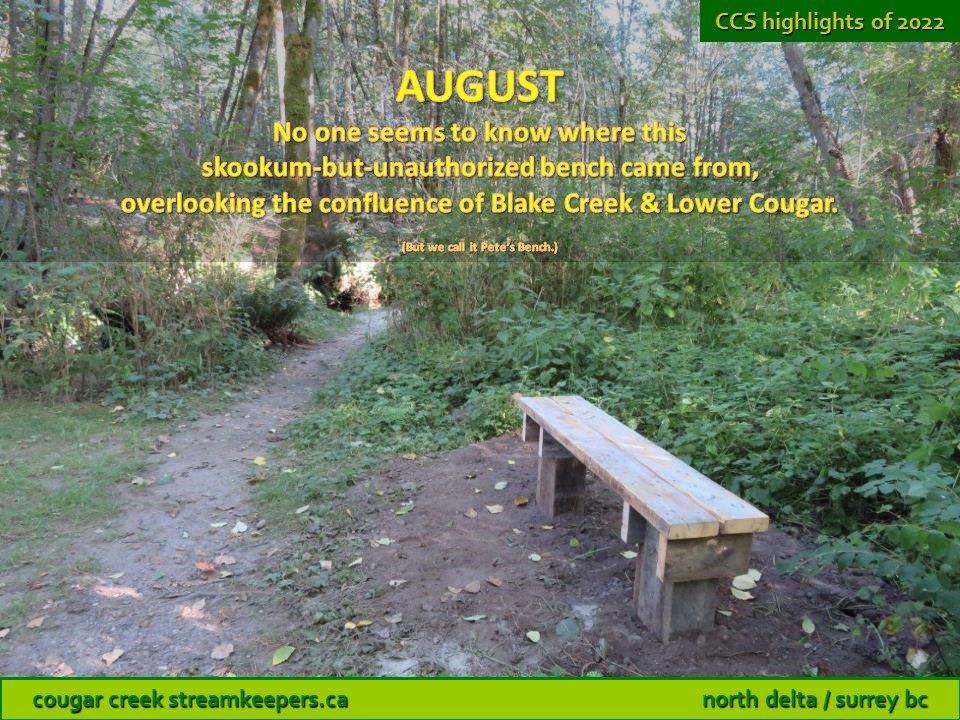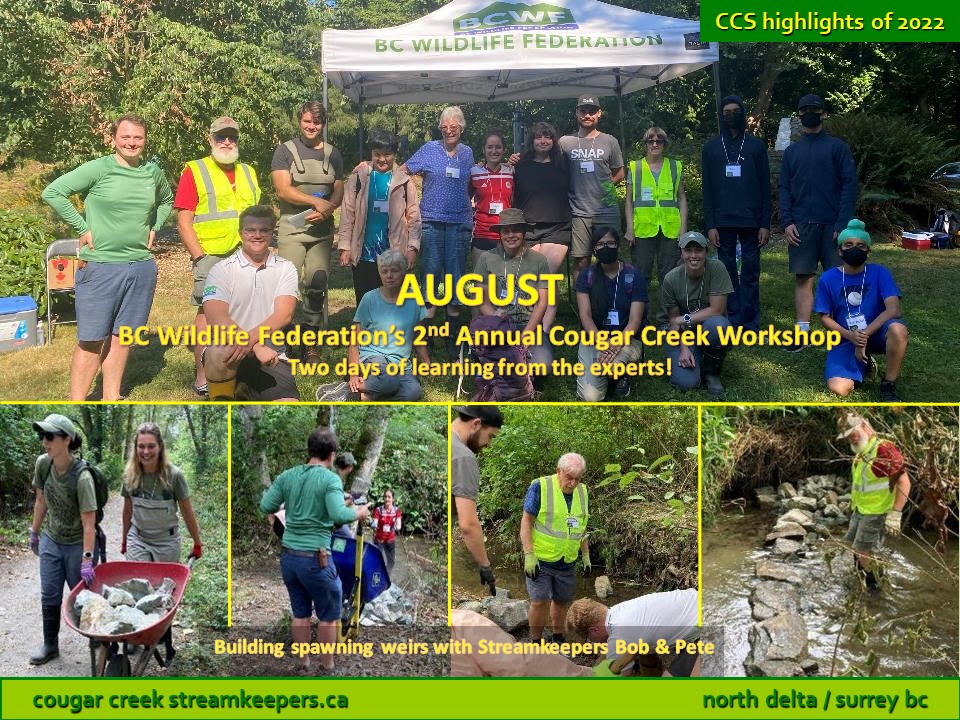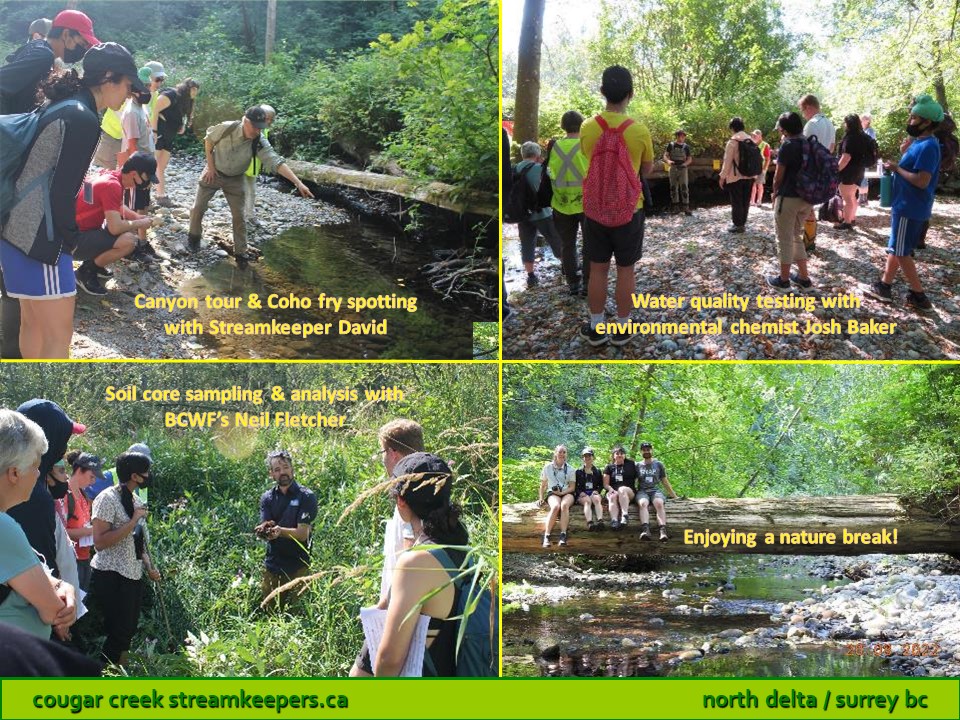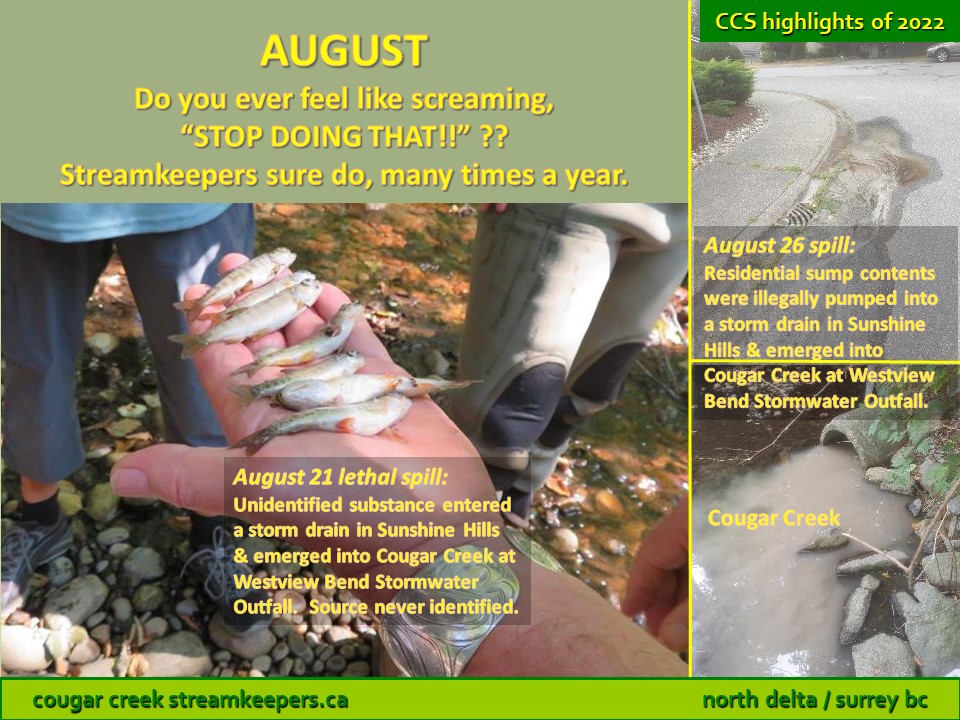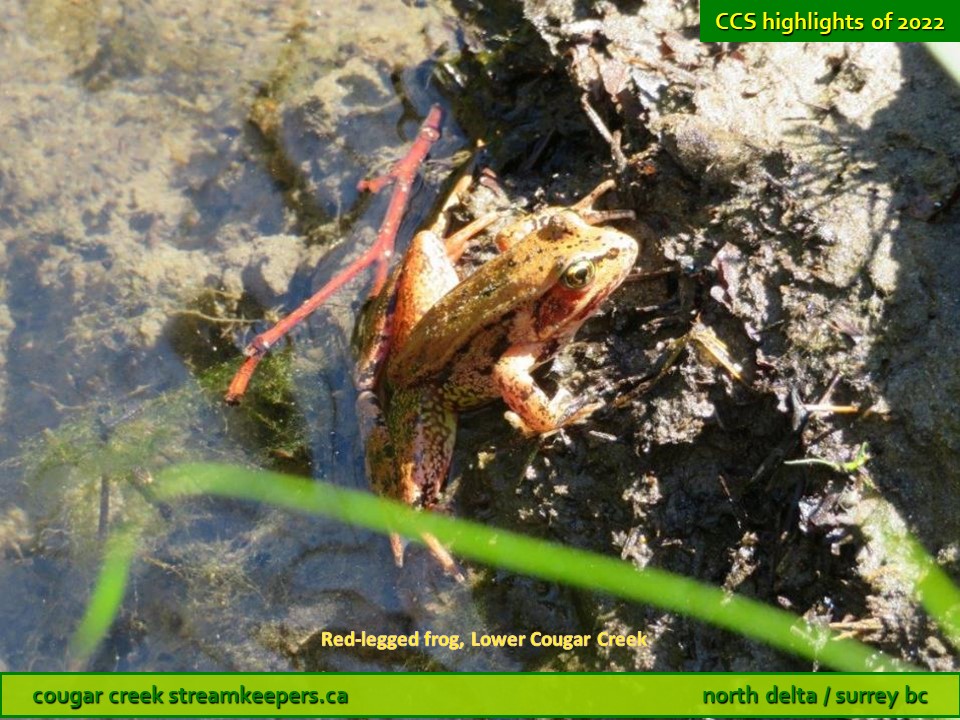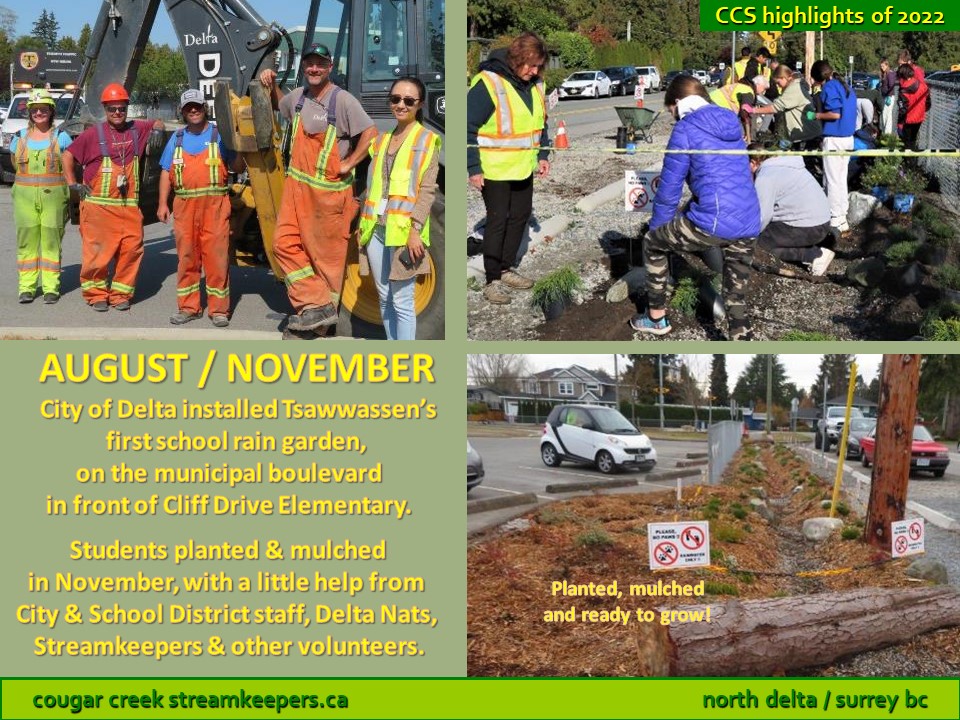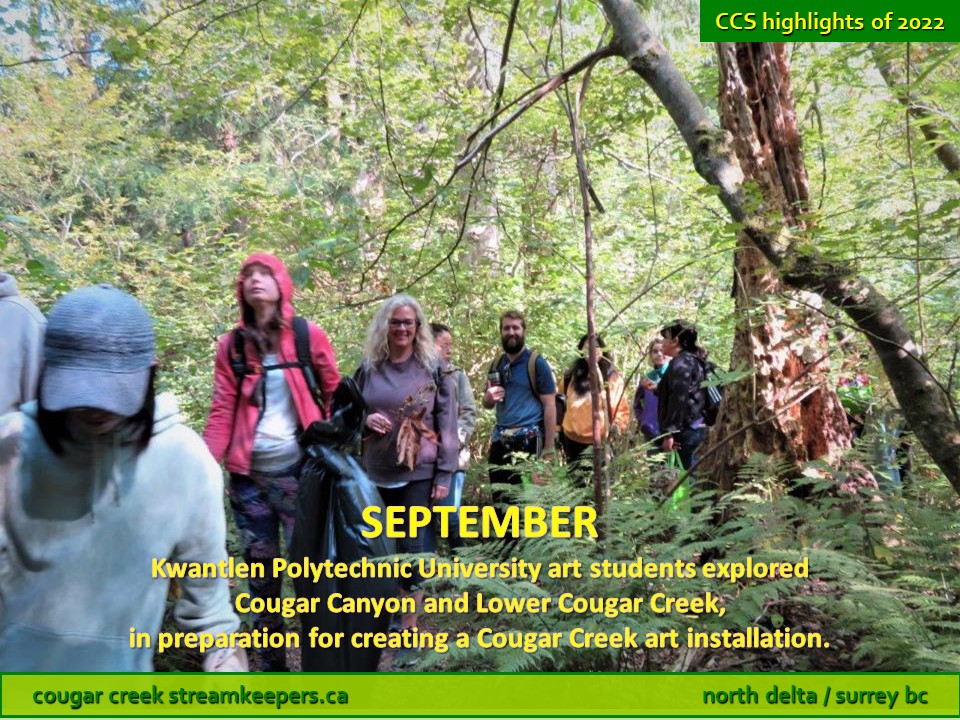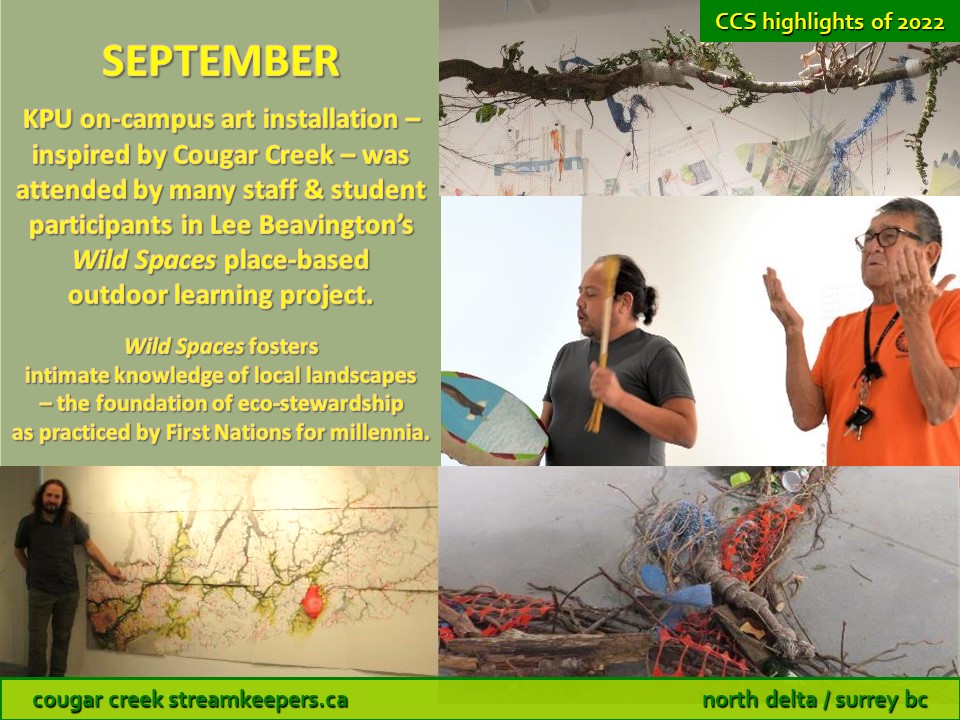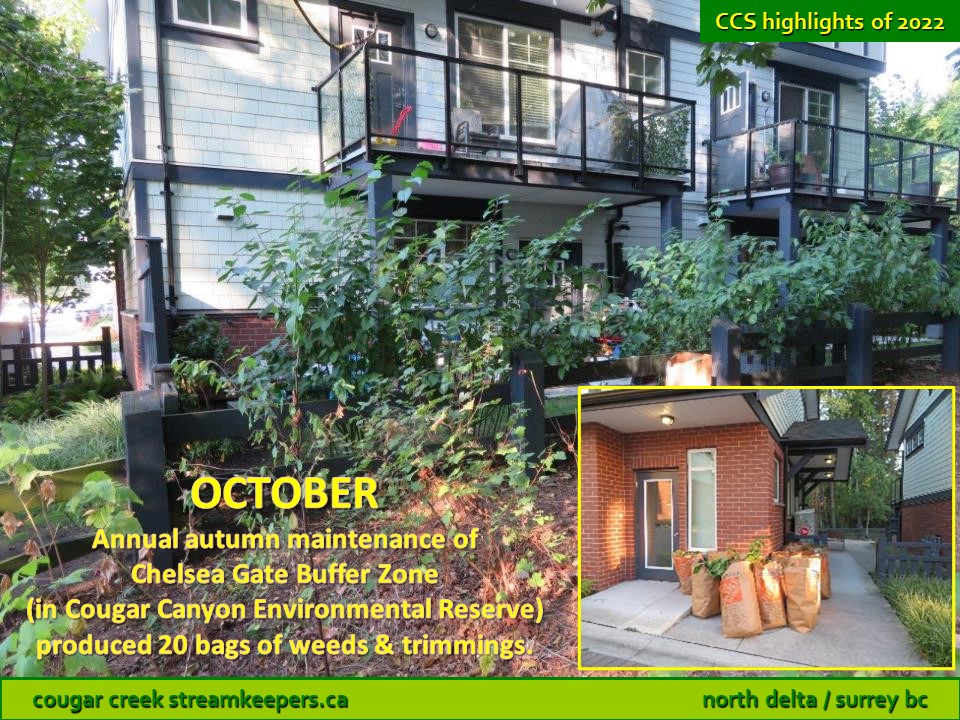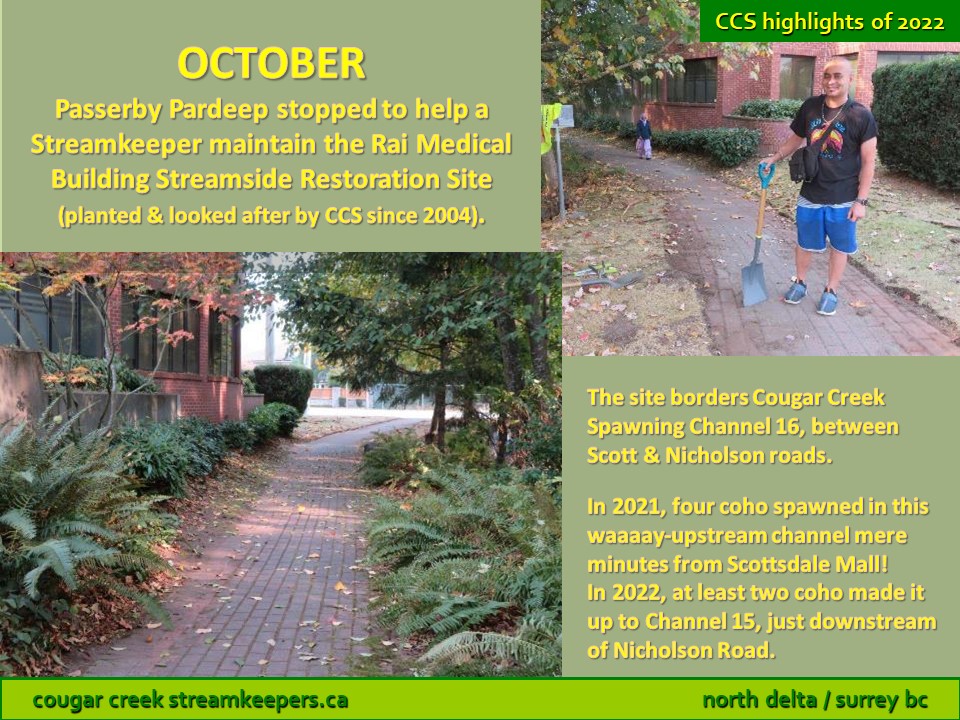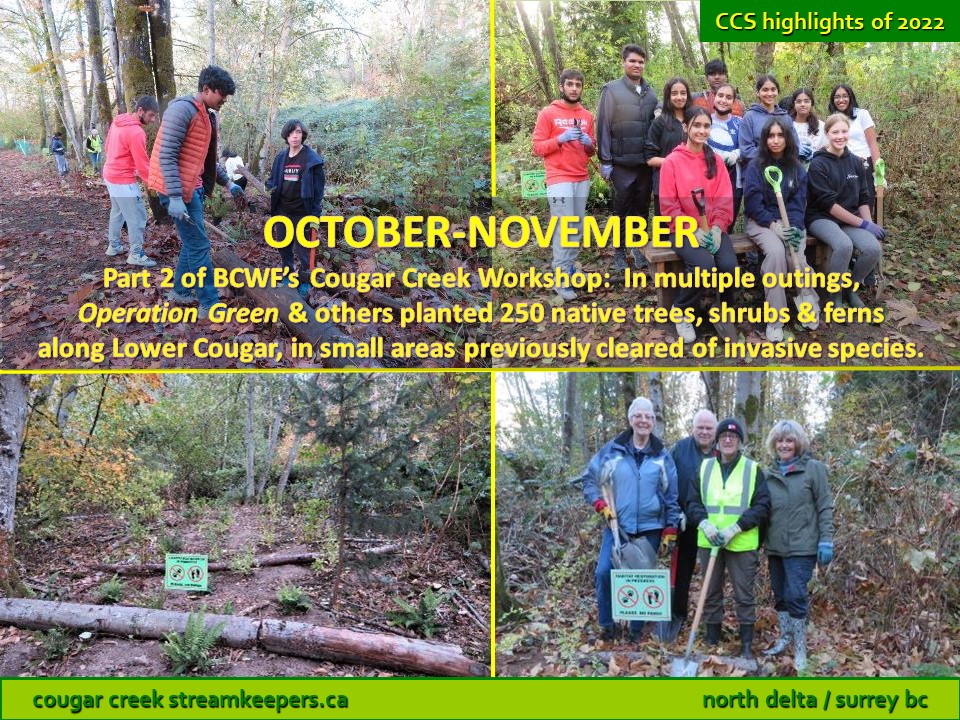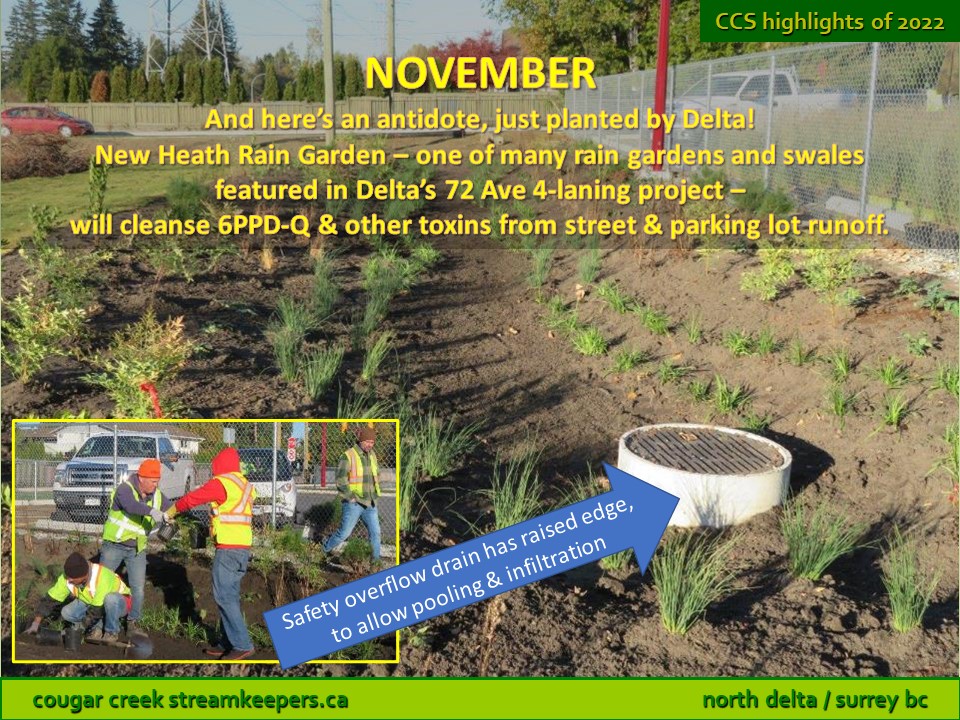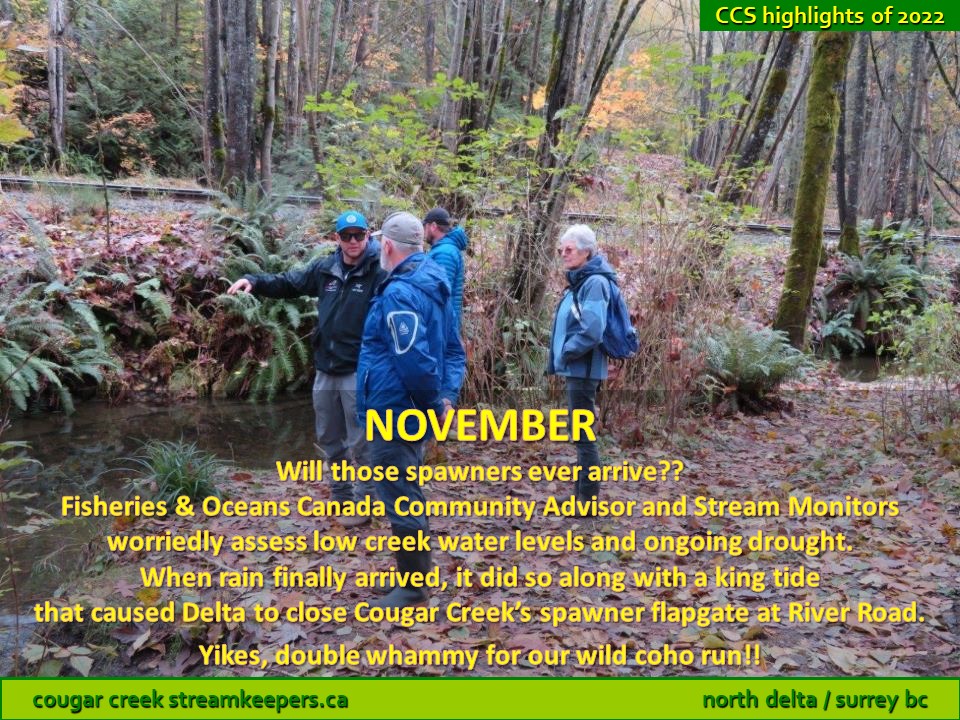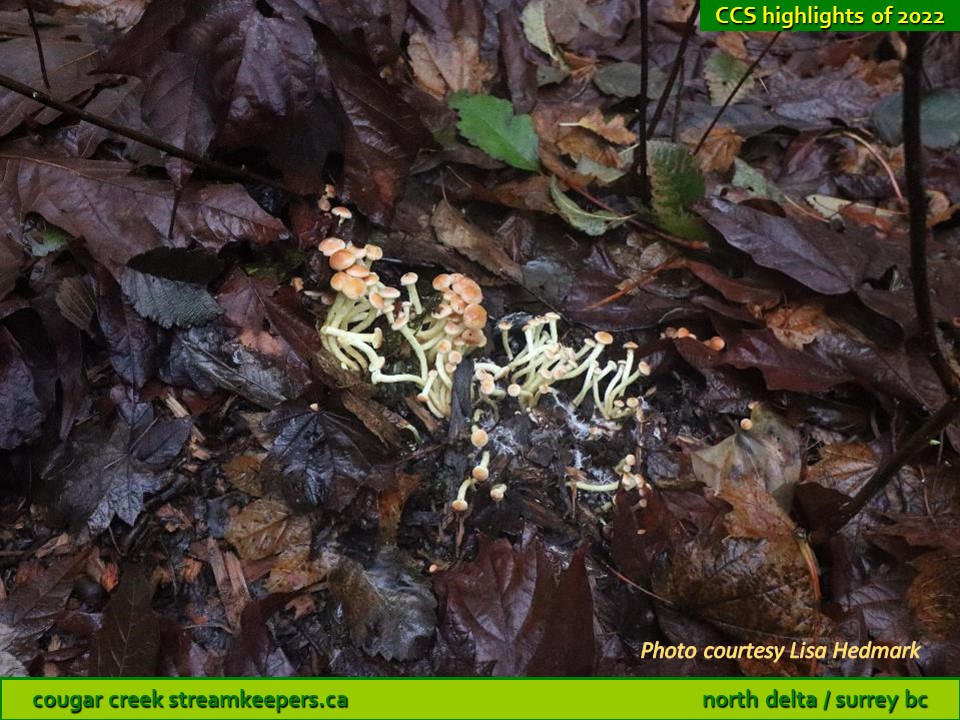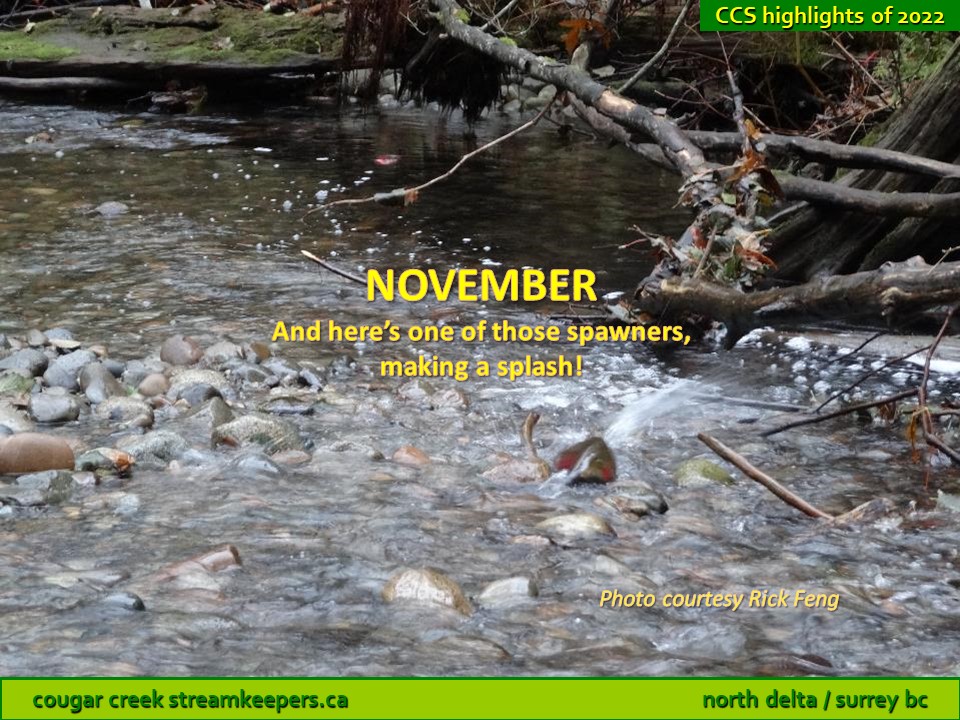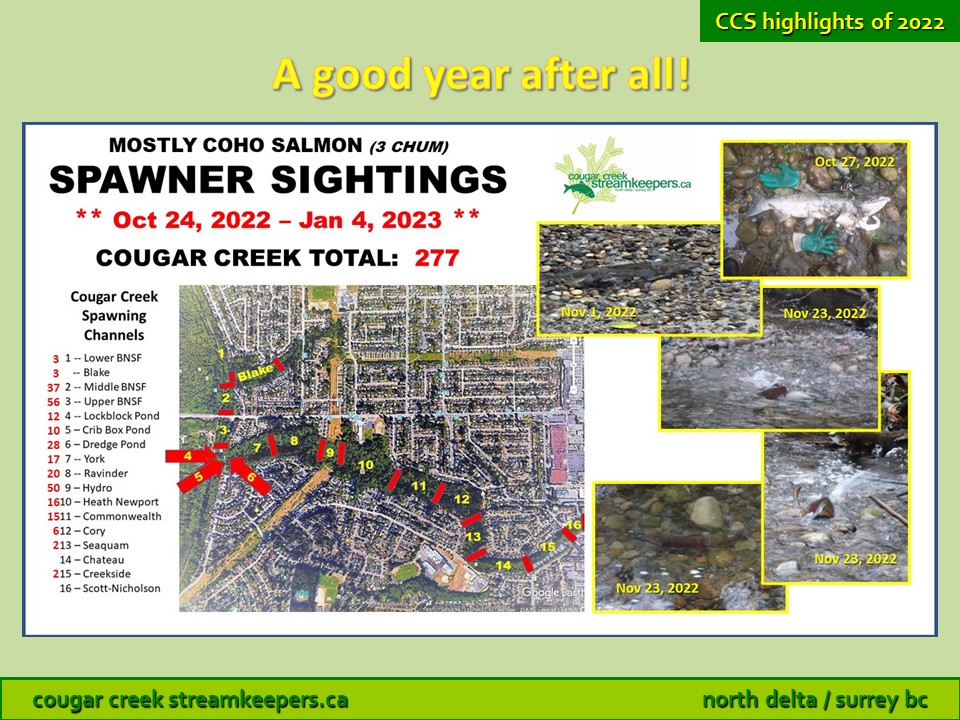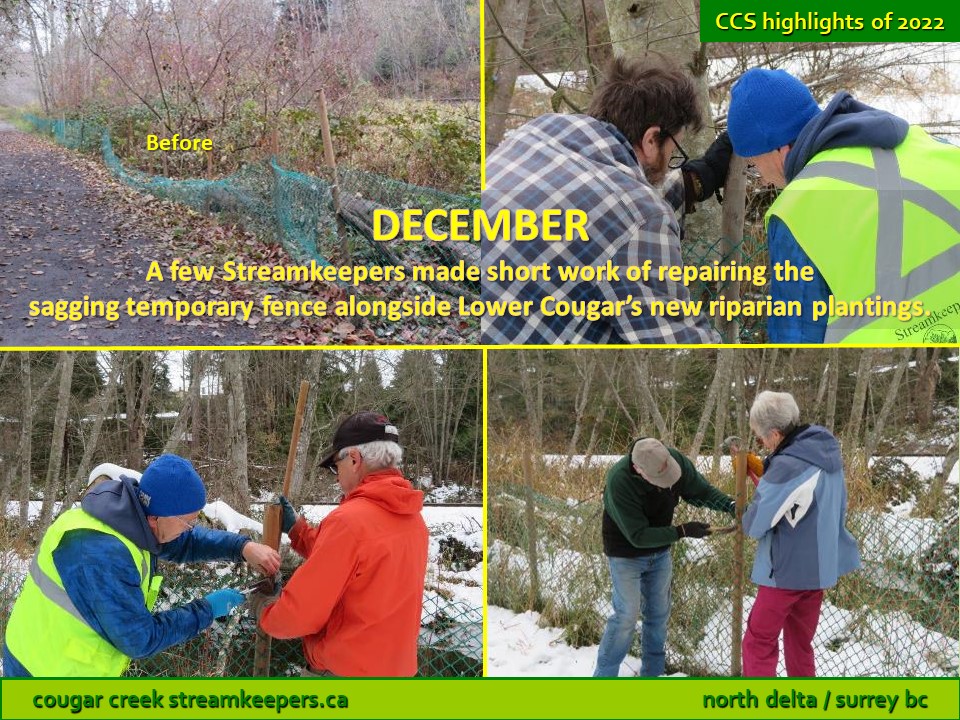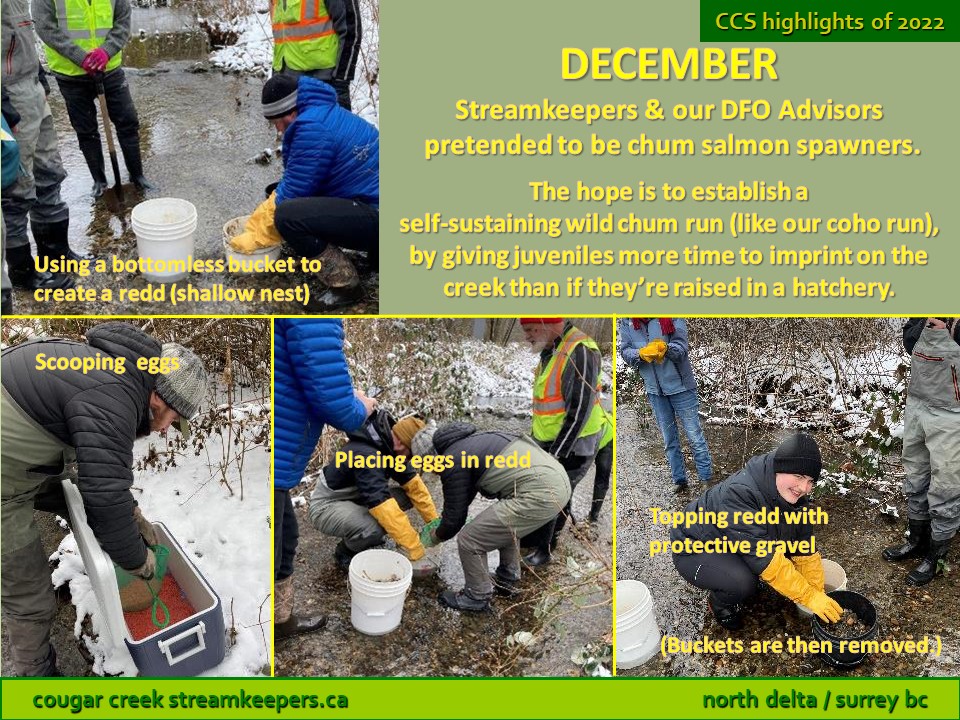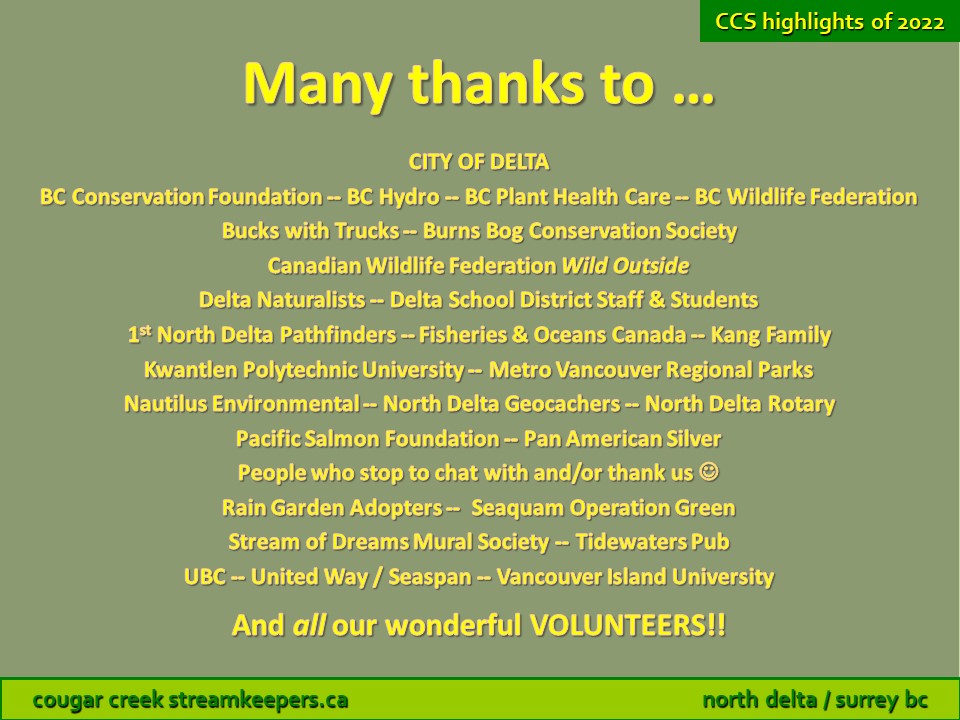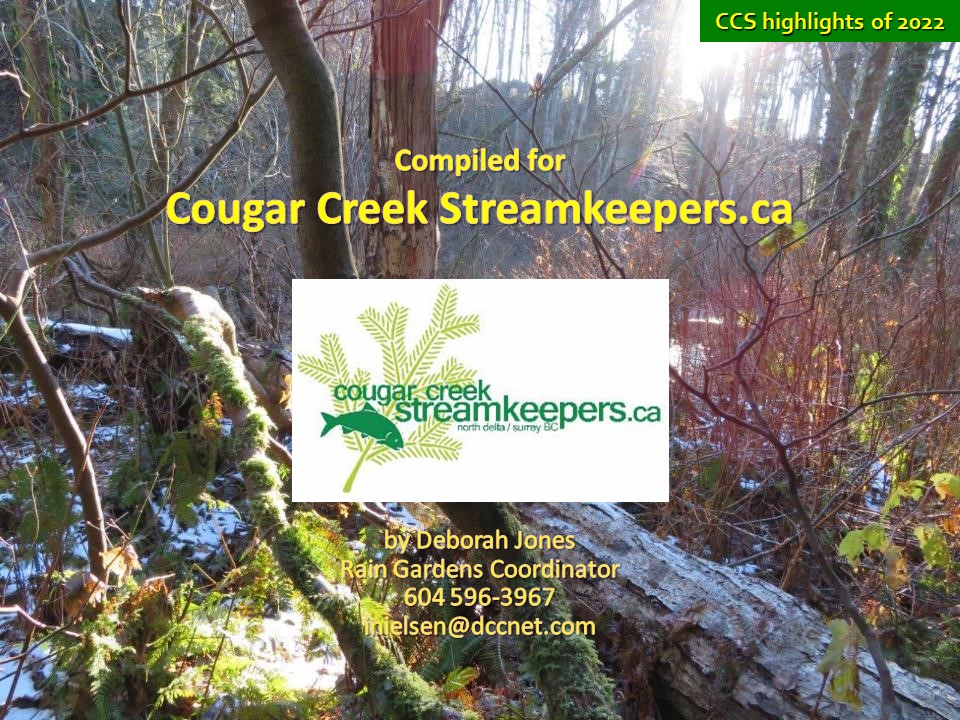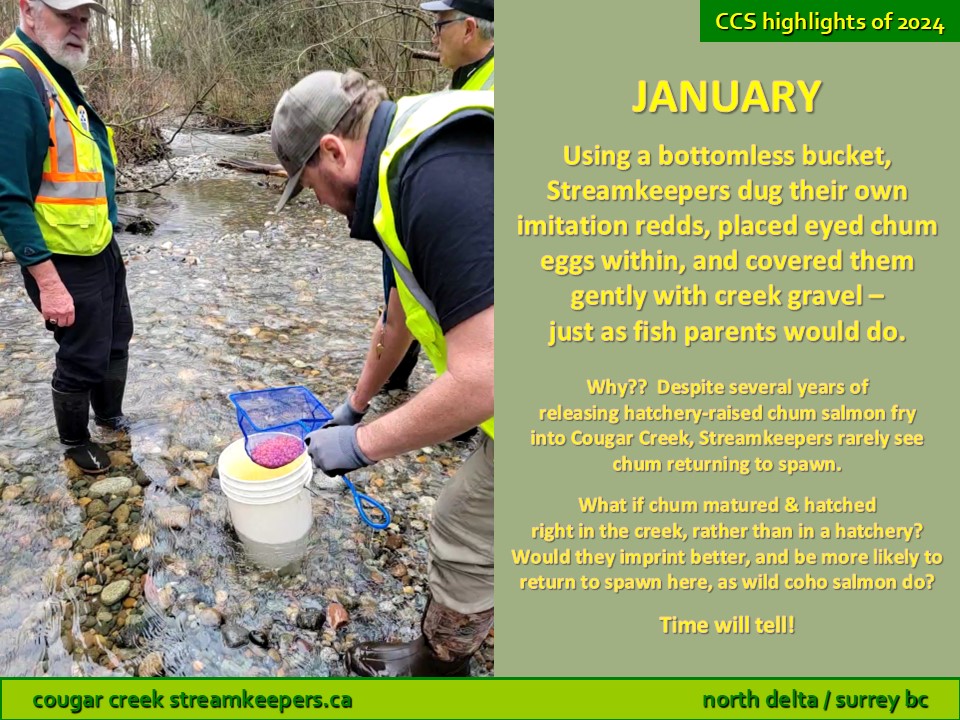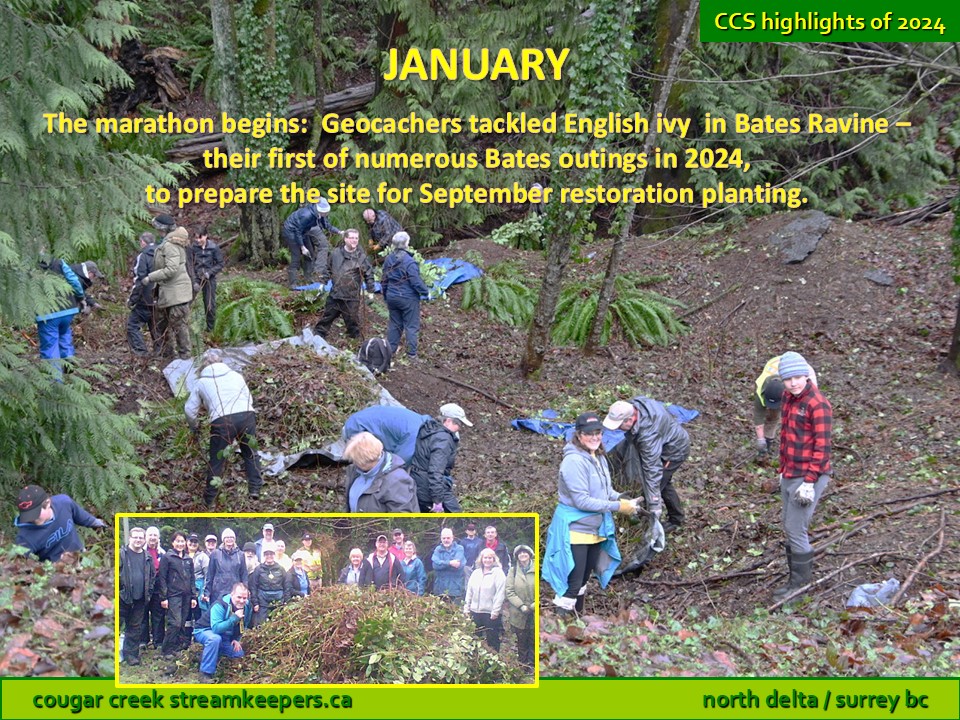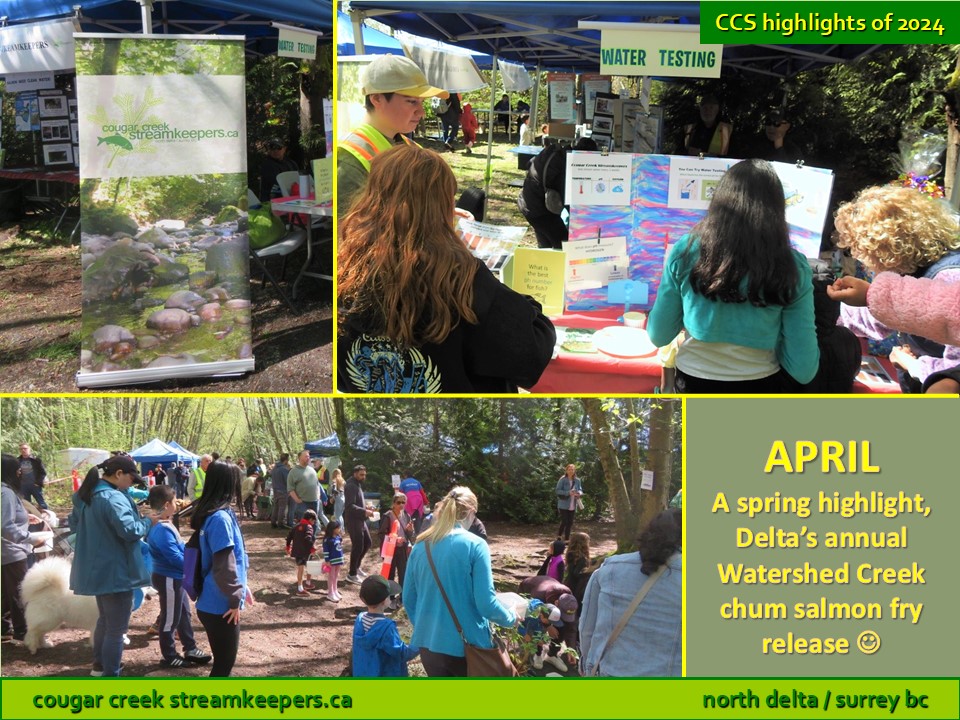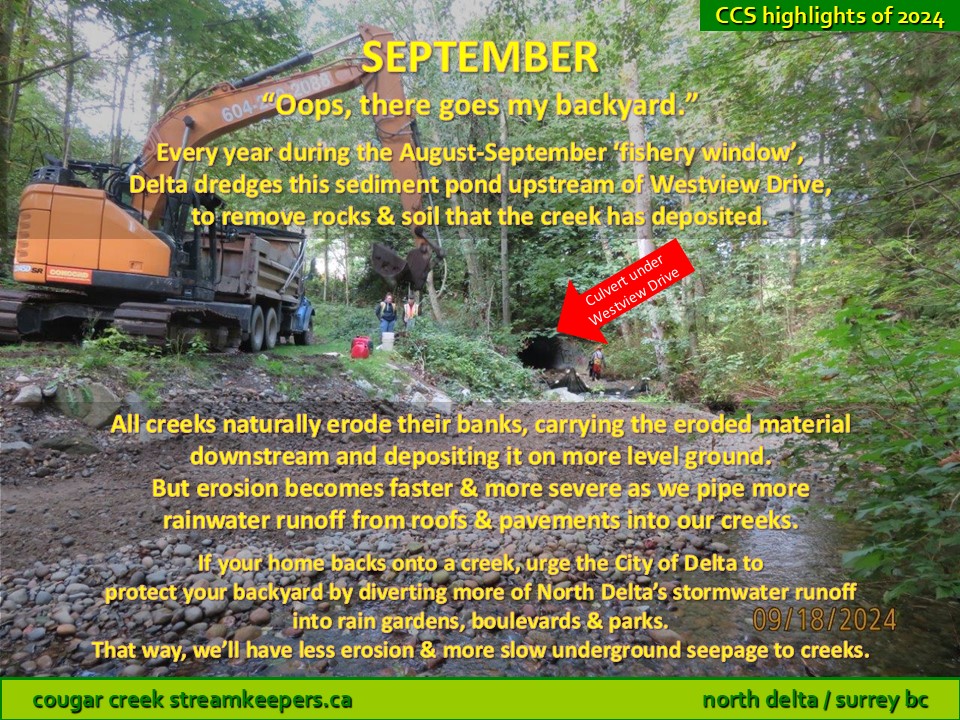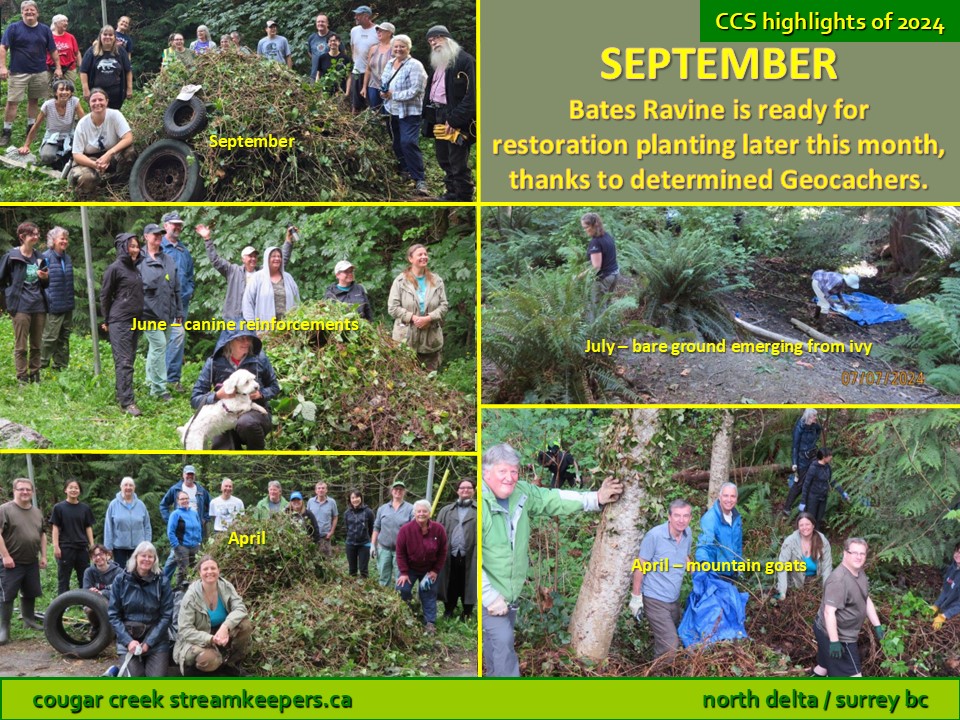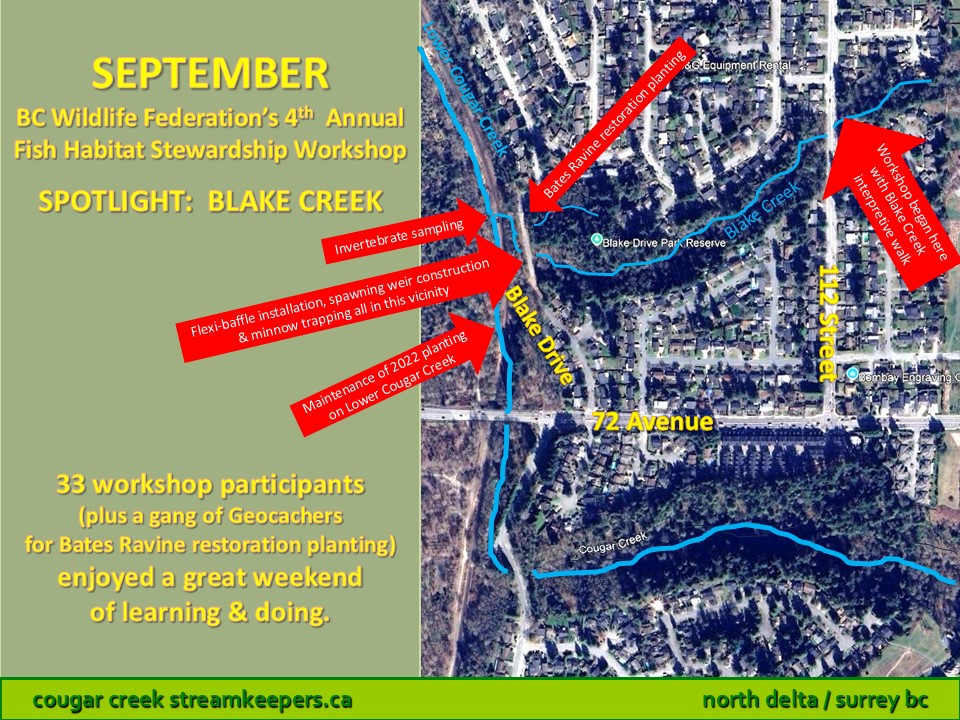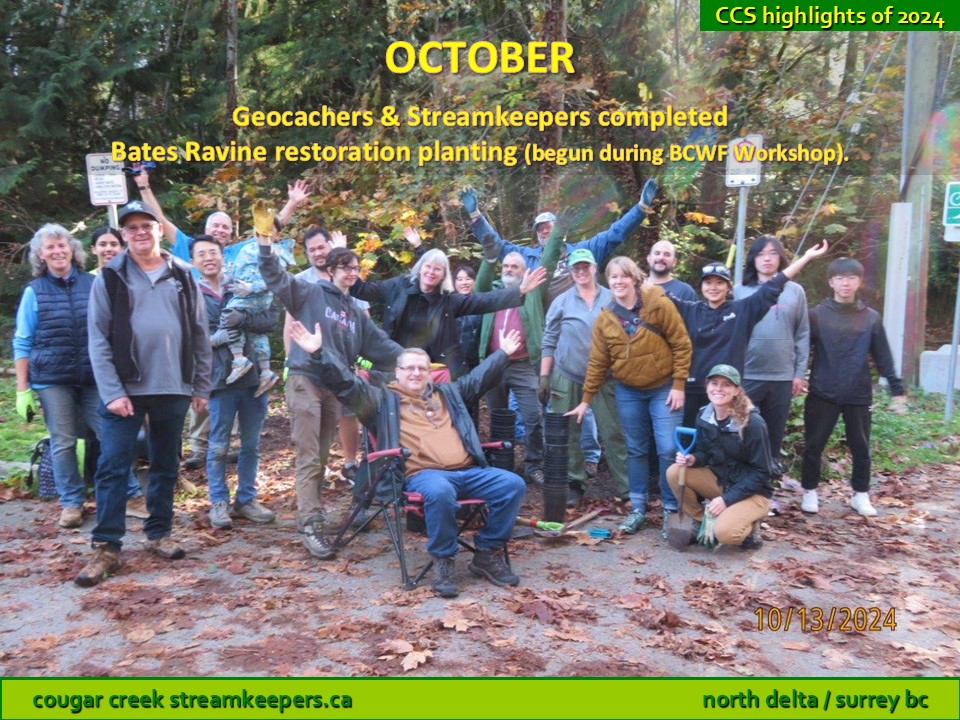On this page:
- Cougar Creek in Photos
- Cougar Creek in Surrey
- Cougar Creek in Delta
- – Scott Road to Nicholson Road
- – Cougar Canyon
- – Westview Bend
- – Lower Cougar Creek
- – Future Prospects
Many Lower Mainland salmon streams have been lost to urban development – piped, buried, polluted beyond saving. Cougar Creek in Surrey/North Delta is one of the exceptions, a beautiful stream that still manages to support both wild and hatchery salmon, as well as cutthroat trout, stickleback, lamprey, crayfish, and sculpin.
Cougar Creek in Surrey
Cougar Creek rises in the West Newton neighbourhood of Surrey, with headwaters emerging from culverts (rainwater drainage pipes) to the north on Strawberry Hill at approximately 122nd Street and 75th Avenue, to the east under the BC Hydro powerline right-of-way at approximately 125th Street and 69th Avenue, and to the south at approximately 122nd Street and 68th Avenue.
The headwaters join together in Cougar Creek Park, where they flow west through man-made stormwater (rainwater) retention ponds. These ponds compensate only in very small part for the loss to development of a marsh and lake that used to extend across what is now Scottsdale Mall and adjacent commercial and residential areas.
From the ponds, the creek flows westward in a straight and narrow man-made channel between two condo complexes, then through a large culvert under Scott Road (120th Street) and into North Delta adjacent to 6905 Scott.
Cougar Creek in Delta
Scott Road to Nicholson Road
Like much of the Surrey portion of Cougar Creek, the Scott Road – Nicholson stretch in North Delta (about 1 block long) is heavily urbanized. Medical buildings, housing, a church, and parking lots crowd far closer to the streambank than is desirable.
Massive flows of stormwater runoff from Scottsdale and other malls, as well as from Scott Road itself, enter the creek on the Delta side of Scott Road. Again, at Nicholson, residential stormwater runoff pours into the creek.
Streambank erosion is a serious problem from Scott to Nicholson, and equally so just downstream from Nicholson – not surprising, given the large amounts of stormwater runoff that are funneled into Cougar Creek in this area.
Streamside restoration projects at the Rai Site and the Soh Site are an important part of streamkeeper efforts to improve conditions along this stretch of creek.
Cougar Canyon
Once past the Nicholson Road culvert, Cougar Creek retains much of its original character as it flows about 2 kilometers westward through the dense mixed forest of the Cougar Canyon Environmental Reserve and down to Westview Drive at approximately 72nd Avenue. A well-designed culvert under Westview is the only culvert along this entire distance. The best spawning grounds are found in the stretch just upstream and downstream from Westview Drive, though wild coho have been known to spawn nearly as far up the canyon as Nicholson Road — quite a trip!
Massive erosion is a concern throughout Cougar Canyon, especially where housing sits close to the streambank (closer than would now be allowed). Some degree of erosion would occur naturally, but the speed and severity of the process have been vastly increased by the great volumes of stormwater runoff that are piped into the creek.
Rain gardens on Lyon Road near Cougar Canyon, including at Cougar Canyon Elementary and Seaquam Secondary schools, show how we can tackle the erosion problem by reducing stormwater flow and increasing groundwater recharge.
Westview Bend
When it reaches more level terrain near the old Westview peat plant at approximately Westview Drive and 72nd Avenue, Cougar Creek originally continued on a southwesterly route through Burns Bog and out to Boundary Bay.
Over many decades, that original route was gradually blocked – first by the rail line, then by the peat plant and a major sewer line, and later by Highway 91 (1986) and a second sewer line. Around 1970, Cougar Creek was “officially” diverted 90 degrees northward into a man-made channel poetically named the Northeast Interceptor Canal (NEIC). The 90-degree bend, coupled with a growing deluge of stormwater runoff from upland development, made the adjacent Burlington North & Santa Fe (BNSF) railroad track highly susceptible to flooding during heavy rains.
The creek cannot be safely channeled underneath the existing tracks without risk of blockage by sediments, nor can the tracks be raised to allow the creek to pass safely under, because trains would then have insufficient safety clearance as they pass underneath the nearby 72nd Avenue overpass.
Ideally, the problem should be addressed at its source, upstream, by retaining or infiltrating stormwater runoff from huge paved areas in the Scott Road corridor. This would reduce both runoff and sedimentation. (See Rain Gardens for more on stormwater retention and infiltration.)
For the immediate term, however, BNSF has increased the height of a lockblock wall to protect its tracks, while Delta has plans for an enlarged sediment pond just upstream of Westview Drive. The more sediments are trapped there, the larger the capacity of Westview Bend to carry heavy flows safely around that 90-degree corner. At least that’s the theory! Stay tuned as Delta Engineering and BNSF continue to grapple with the problem.
Lower Cougar Creek
As the Northeast Interceptor Canal (NEIC) gradually naturalized over the decades, and became an established salmon migration route and spawning channel in its own right, the City of Delta and Cougar Creek Streamkeepers agreed that a more suitable name was in order. In 2017, the NEIC was officially renamed Lower Cougar Creek.
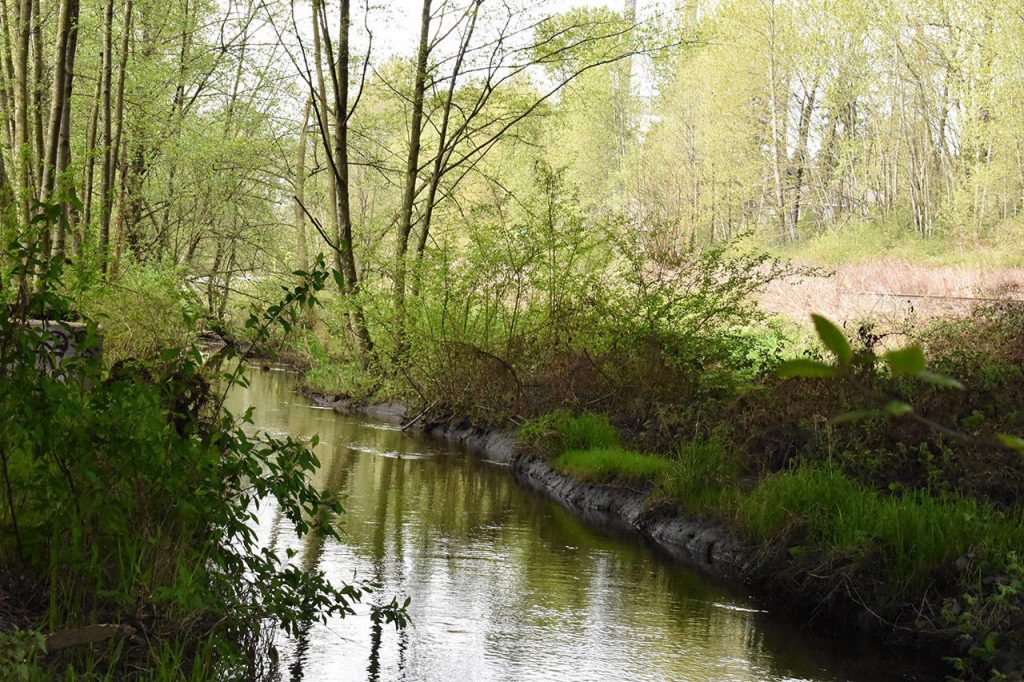
As Lower Cougar Creek flows northward about 3 kilometers to the Fraser River, it parallels the BNSF railroad track, twinned sewage lines and a pair of popular multi-use recreational trails. It passes between subdivisions to the east and — to the west — the Delta nature Reserve, a large ice rink complex, an extensive shipping container storage facility and a large lumber yard. It finally empties into the Fraser River just west of the Alex Fraser Bridge.
The same voluminous stormwater flows that cause erosion in Cougar Canyon and risk of flooded railroad tracks at Westview Bend are also at work in Lower Cougar Creek. During winter rains, a wide swath of riparian zone is often flooded — including a popular trail alongside the creek (future Delta/South Surrey Regional Greenway).
Although occasional spawners become stranded off-channel when the creek overflows its banks, on the whole it’s fortunate that the riparian corridor is wide and natural enough to accommodate this process. Creeks whose channels are cinched in by dykes are generally far less healthy than those that are allowed to spread and meander during heavy rains.
Future Prospects
Cougar Creek has good potential for restored stream health and wild salmon runs. Culverting is not extensive, native streamside vegetation is fairly abundant (especially in Cougar Canyon Environmental Reserve and bordering the Delta Nature Reserve), and there are many potential rearing areas where juvenile salmon can take shelter. Check out our Creek Enhancement projects to learn about ongoing improvements being undertaken by Streamkeepers in collaboration with the City of Delta, Surrey’s SHaRP program (Salmon Habitat Restoration) and our many youth and adult volunteers.
The greatest challenges to creek health include
- torrential stormwater runoff during rain events, followed by low water levels during dry spells
- pollution from storm drains, including: tire & brake dust, tailpipe toxins, oily residues from fresh asphalt, carwashing soapsuds, plastic litter, cigarette butts, and unfiltered drainage of basement excavations, swimming pools, hot tubs, pressure washing
- non-biodegradable religious offerings such as plastic flowers, red fabric banners, icons
- lack of sufficient vegetation/shade in some areas, due in part to heavy pedestrian/bicycle traffic and numerous dog beaches
- dogs entering the creek during the critical period for salmon reproduction (roughly November 1 through May 1)
- culverts and debris traps that discourage fish passage
- potential leaks from Metro Vancouver sewage lines
- leachate from the lumber yard.
Miraculously, coho & chum salmon, cutthroat trout and other fish continue to survive in Cougar Creek. Given half a chance, nature heals itself!














































